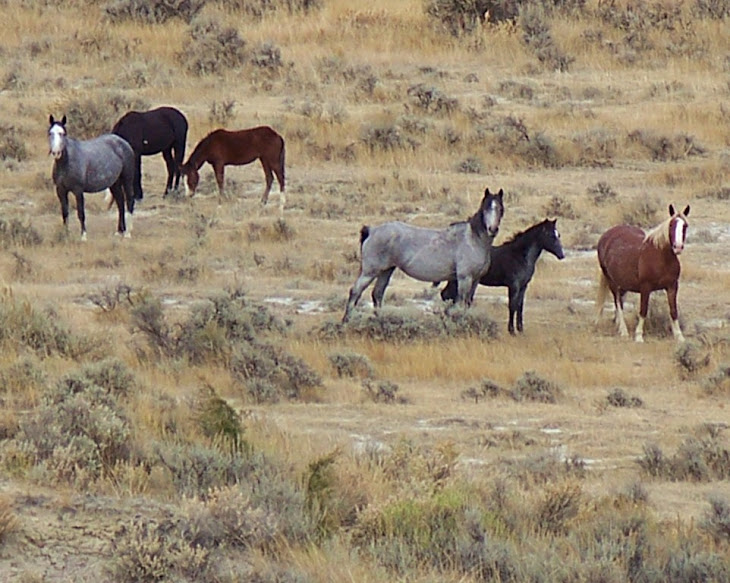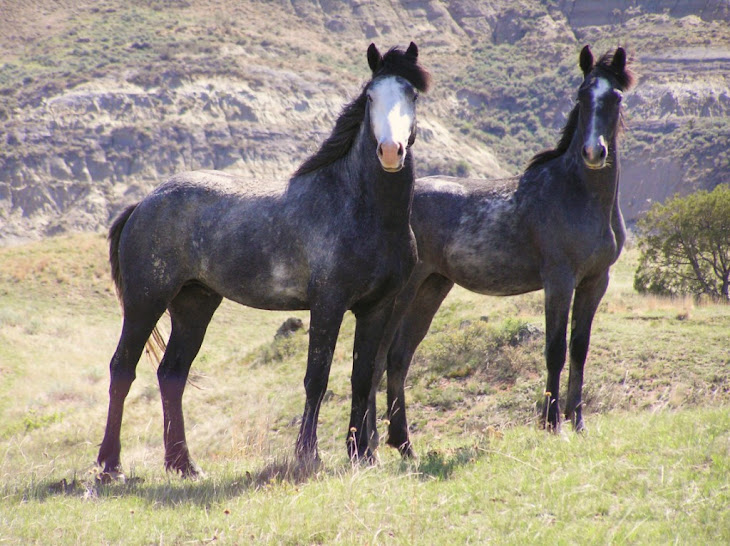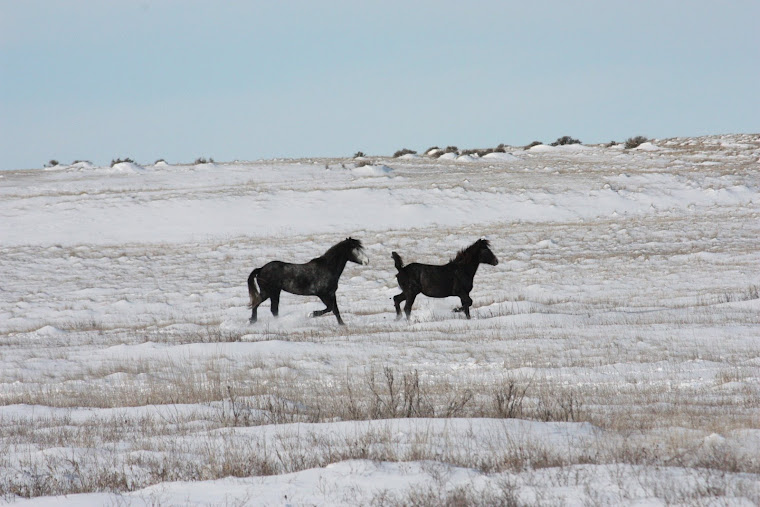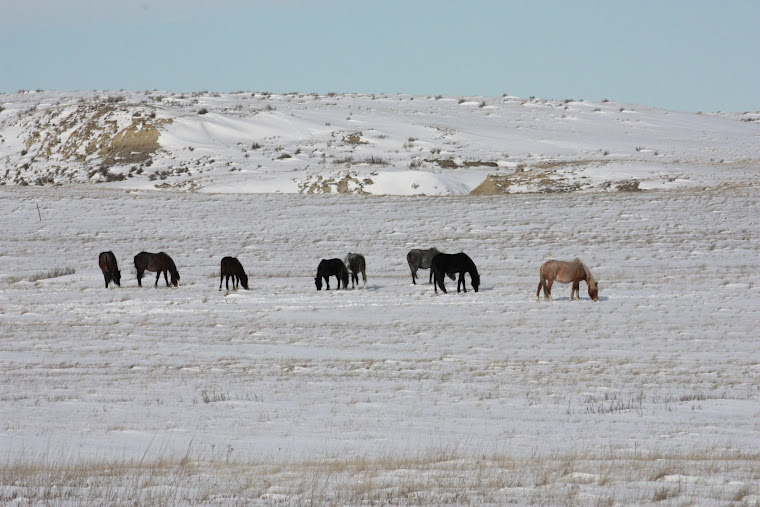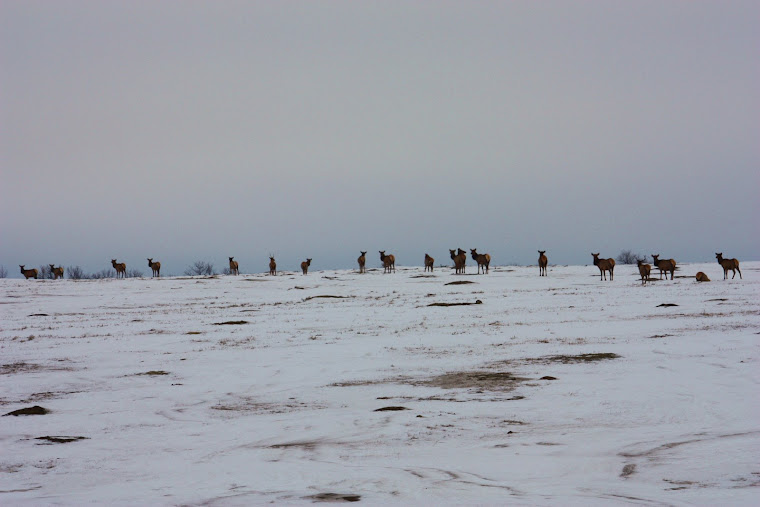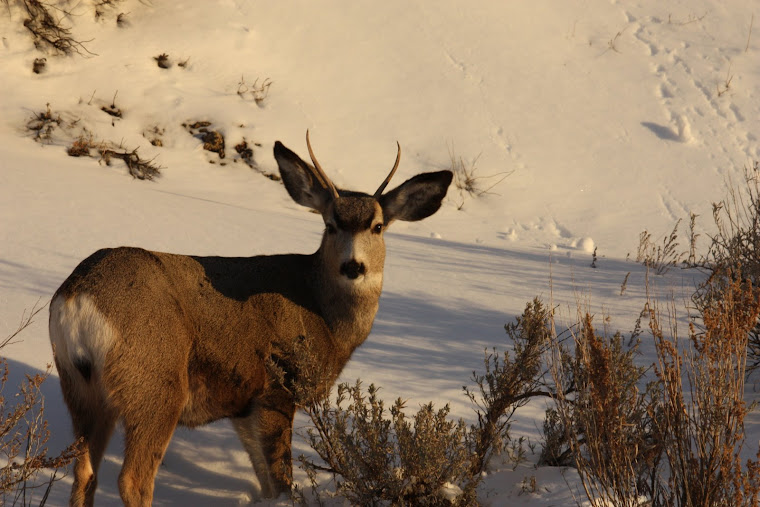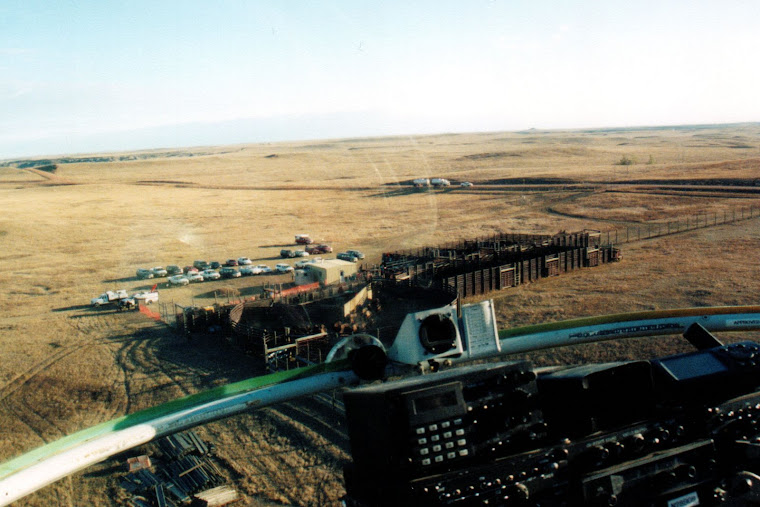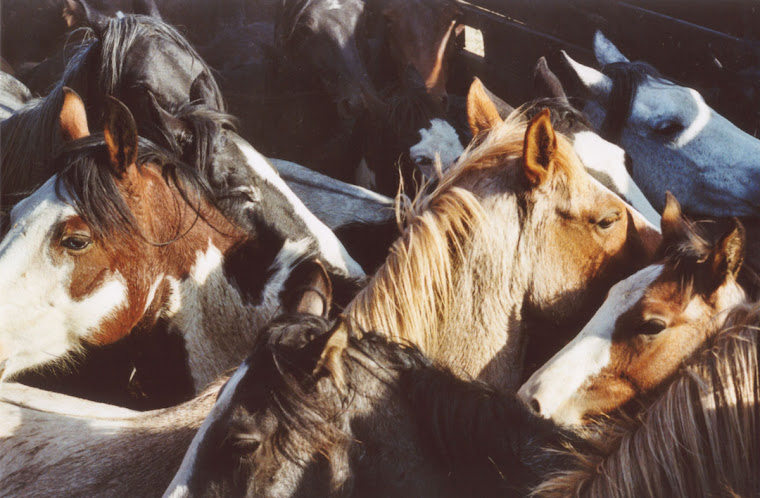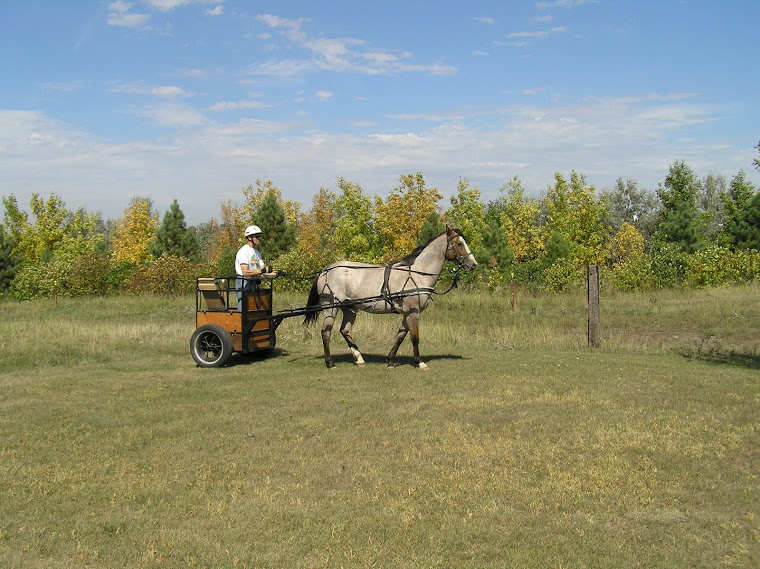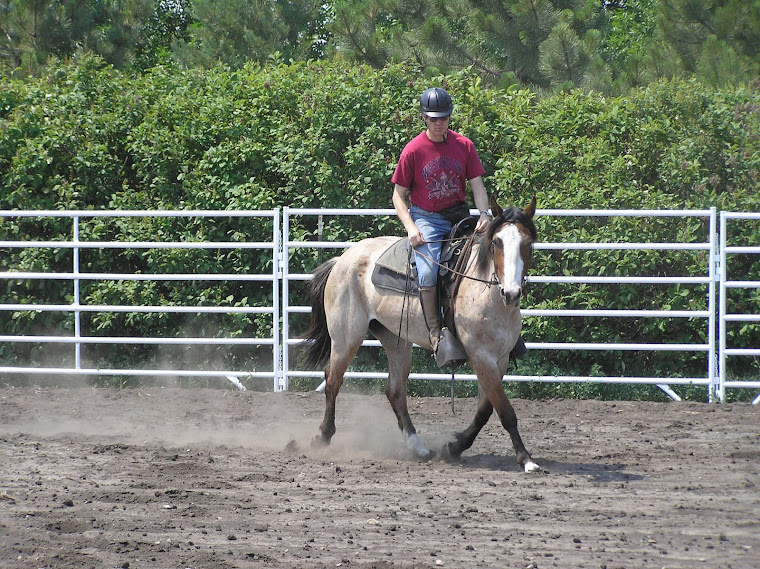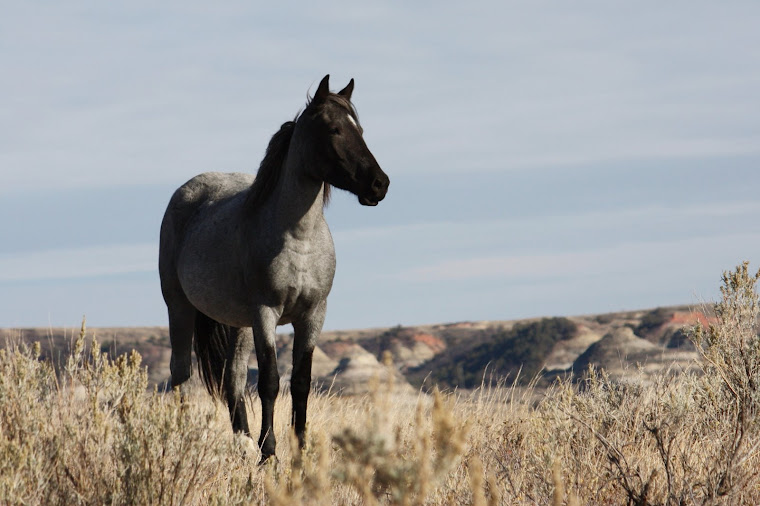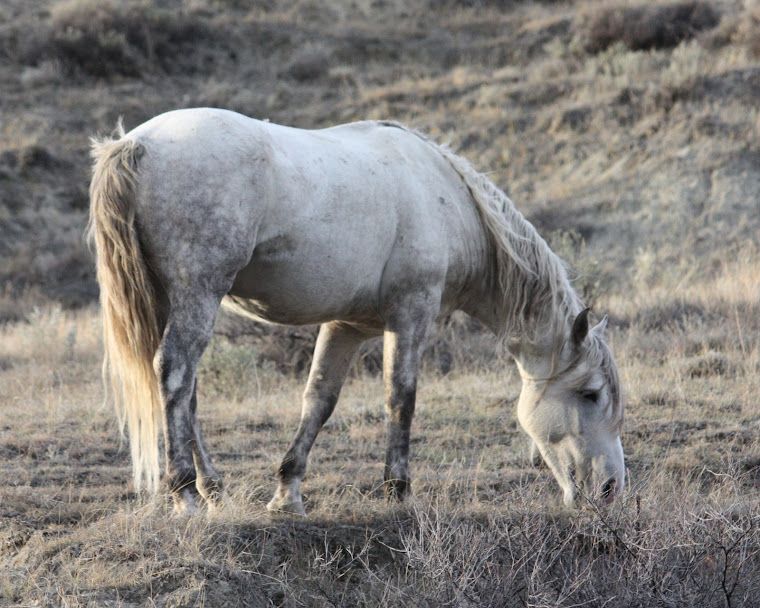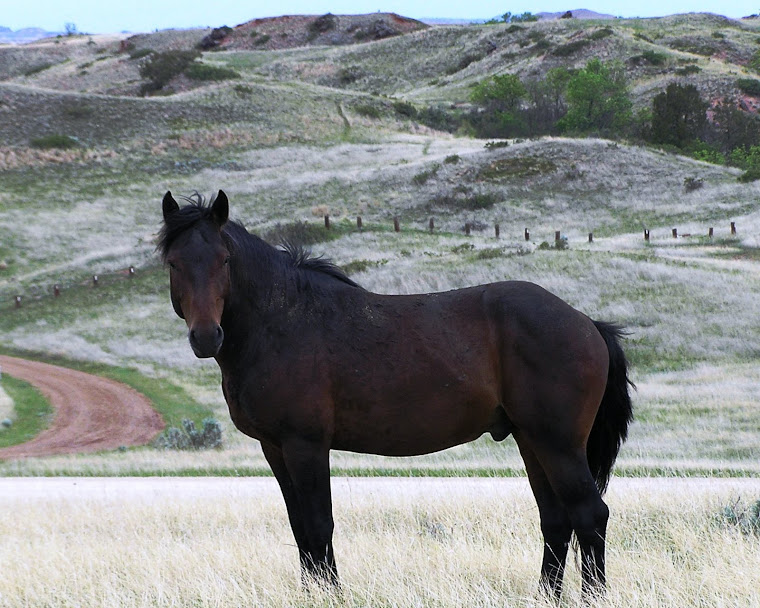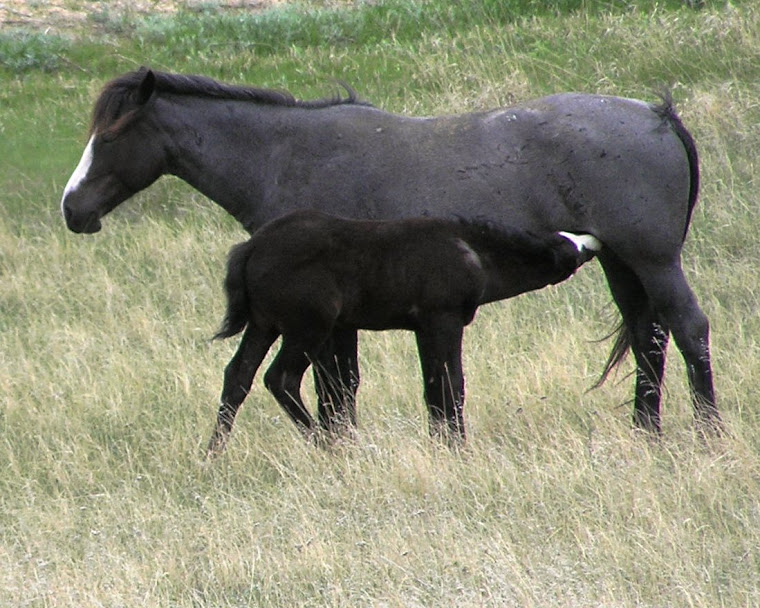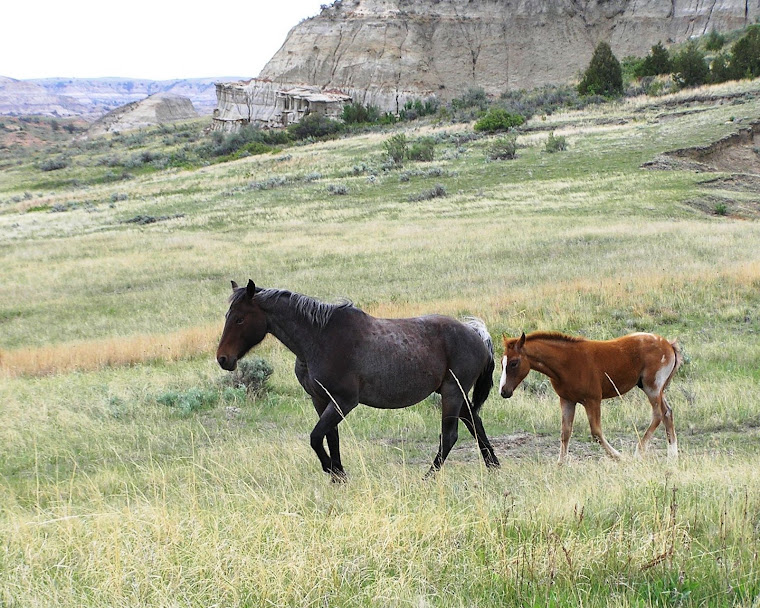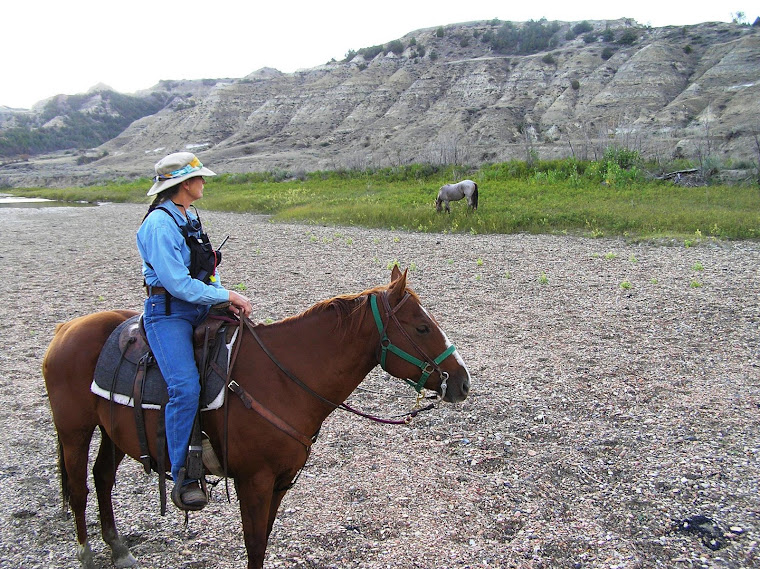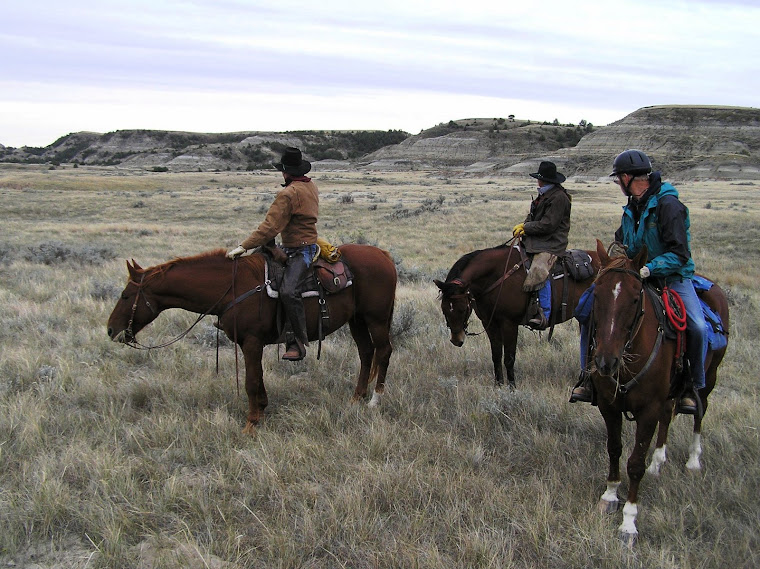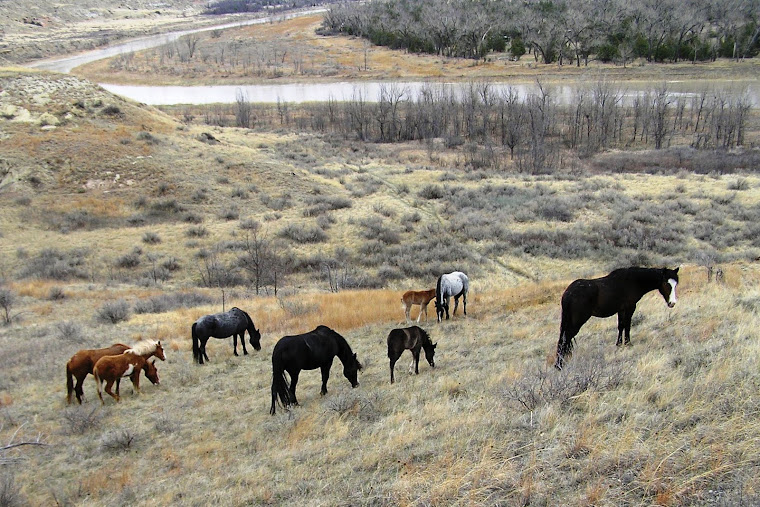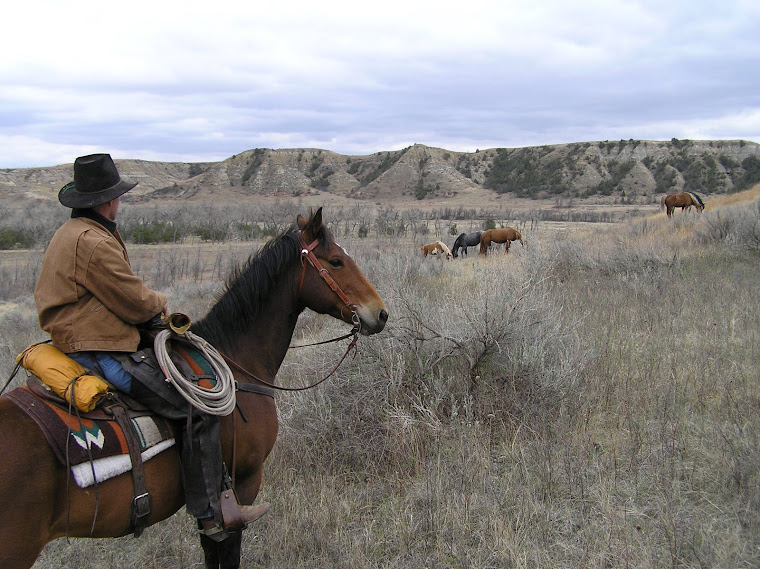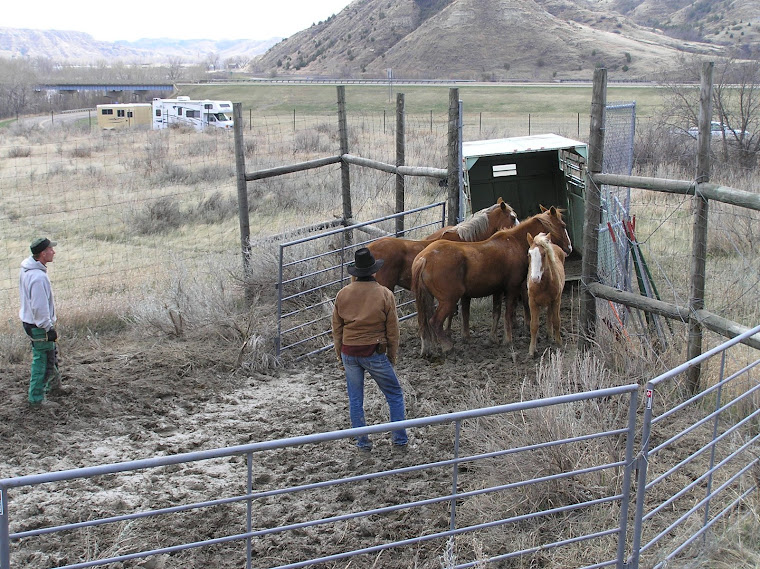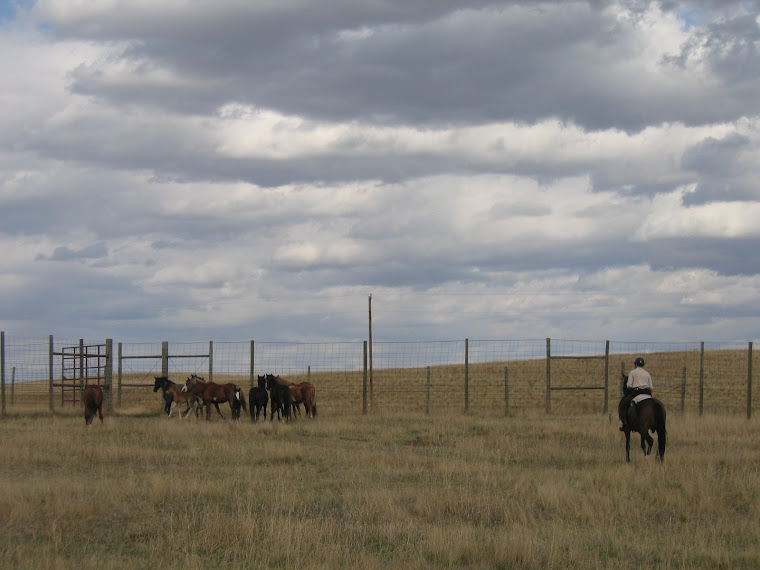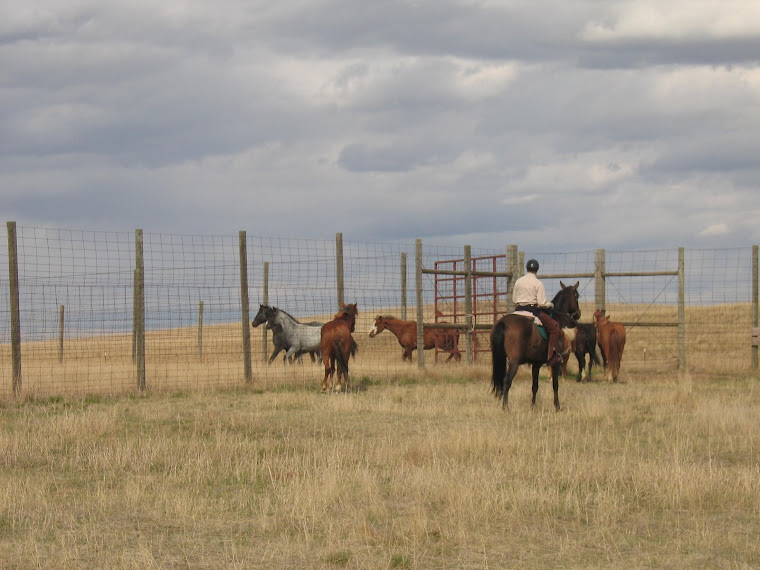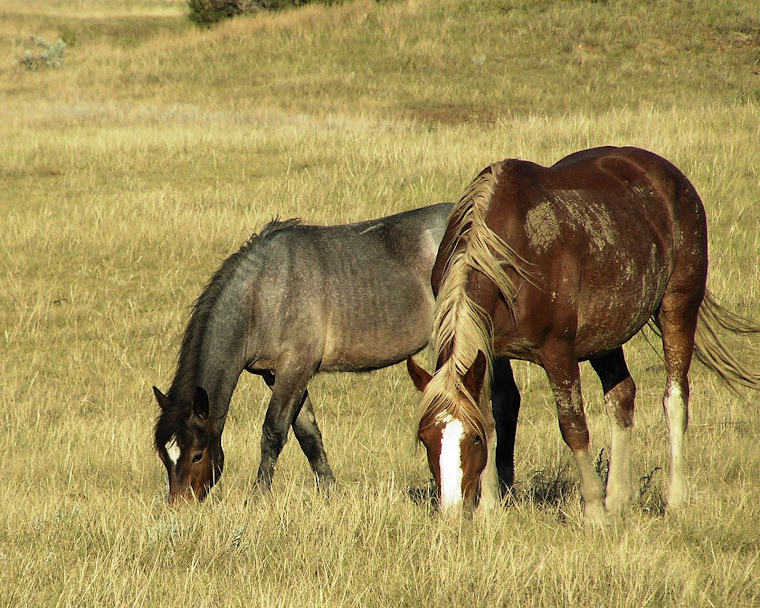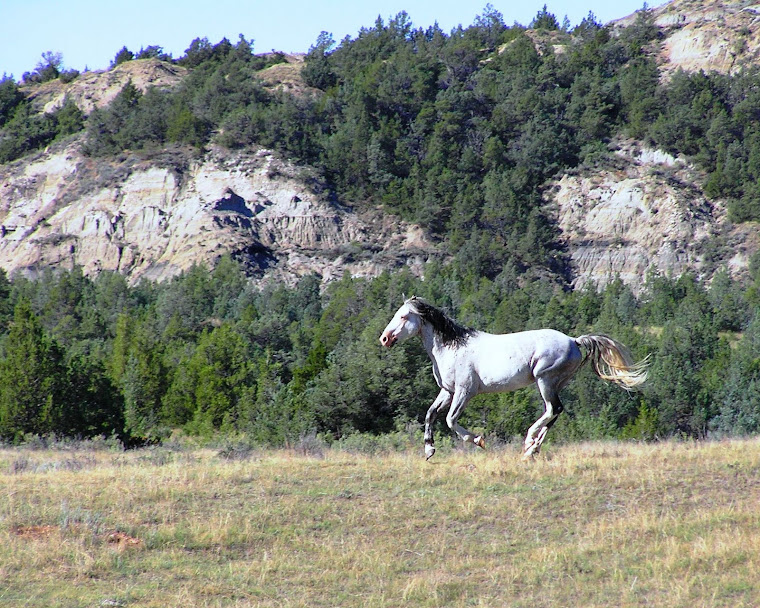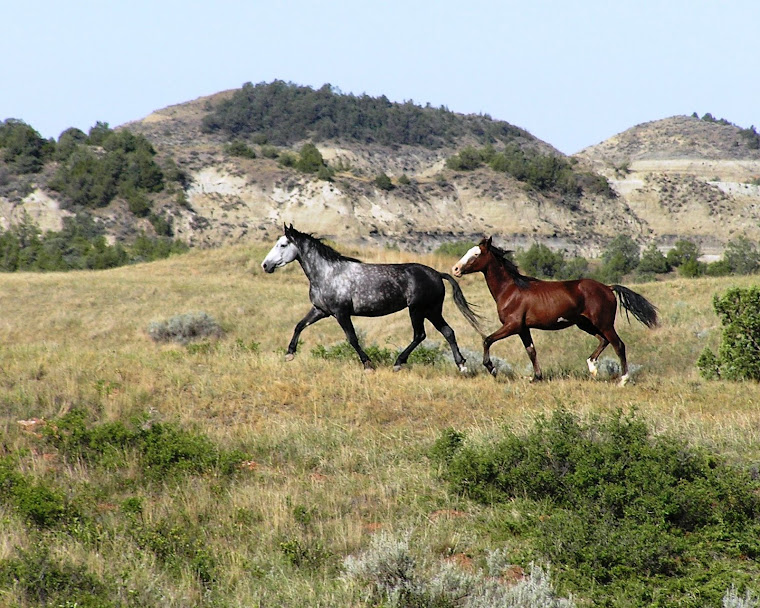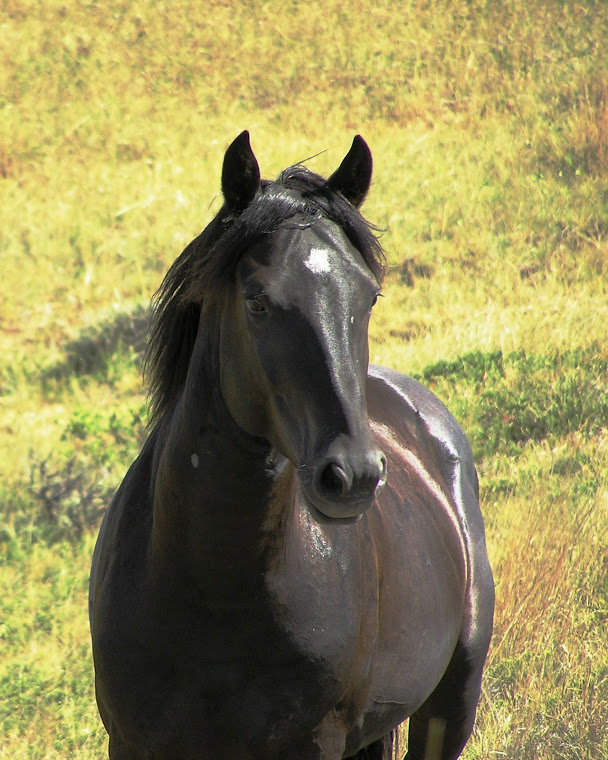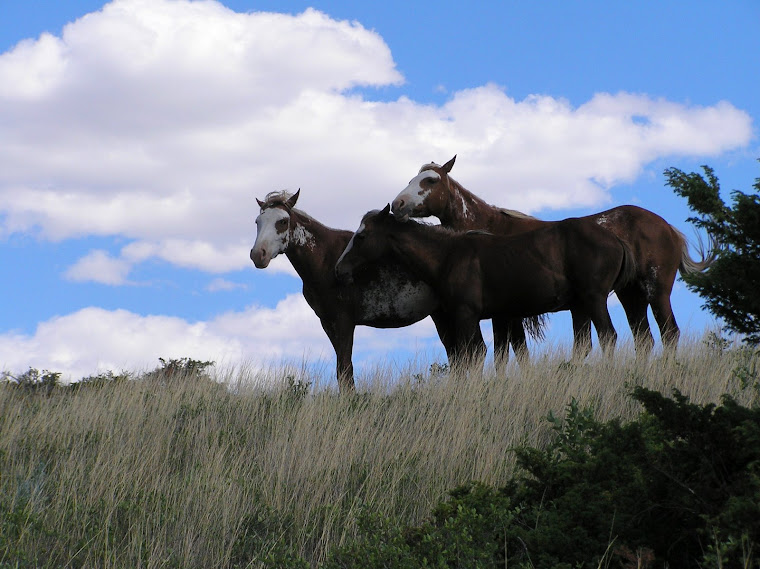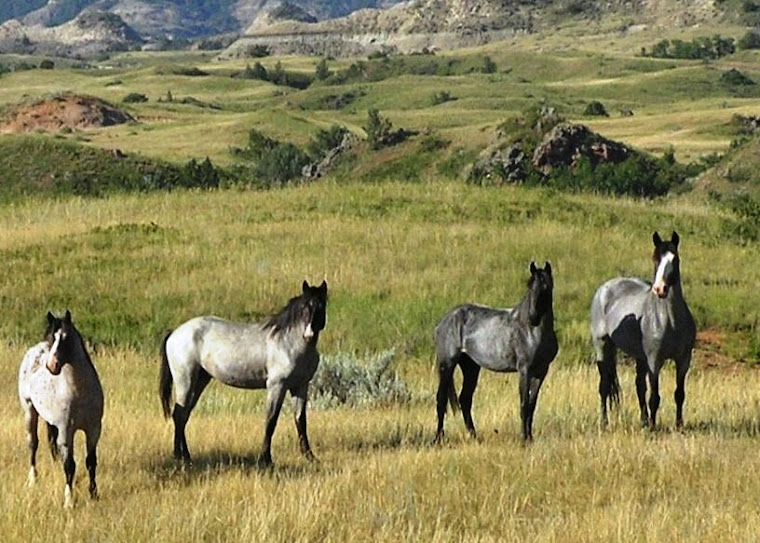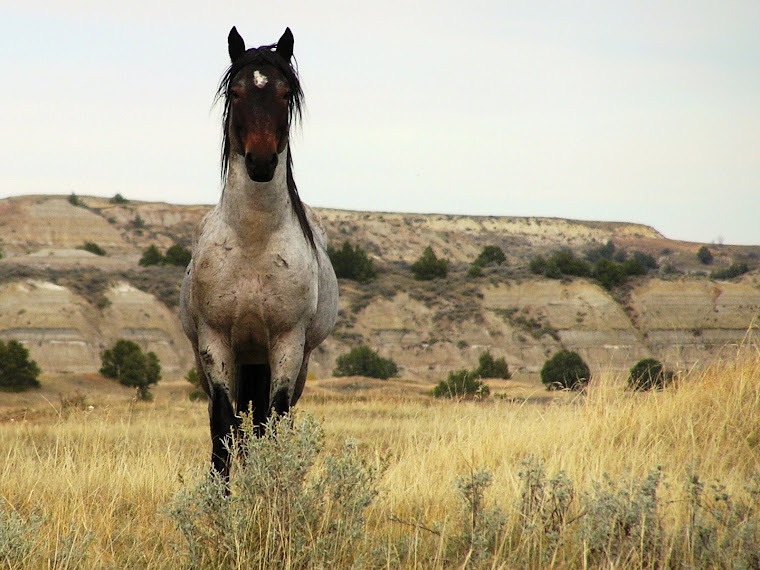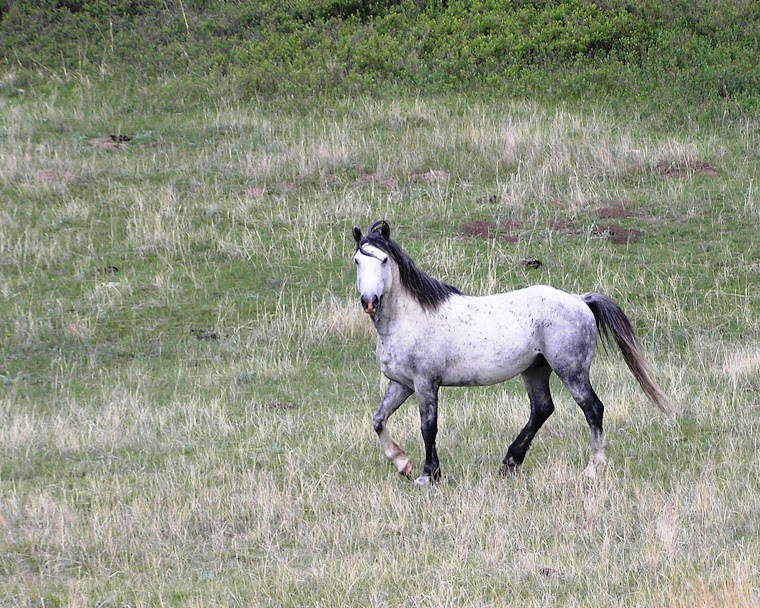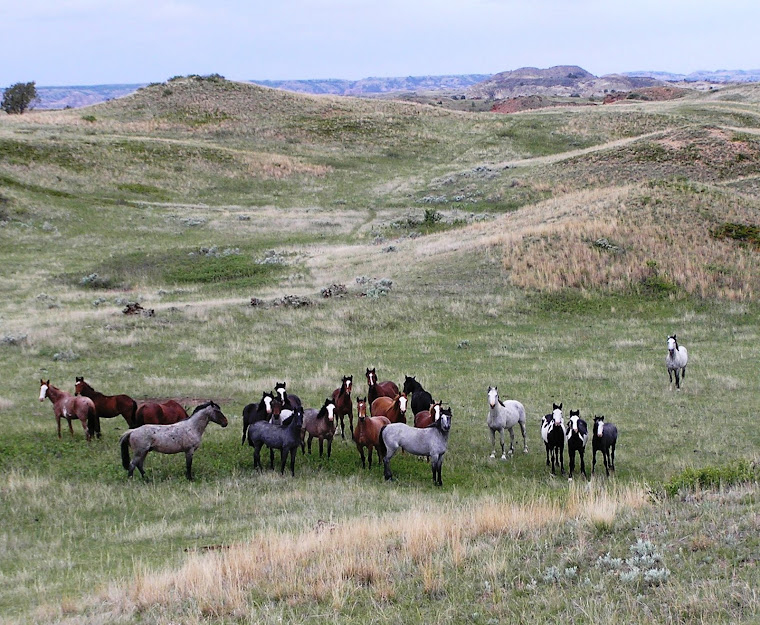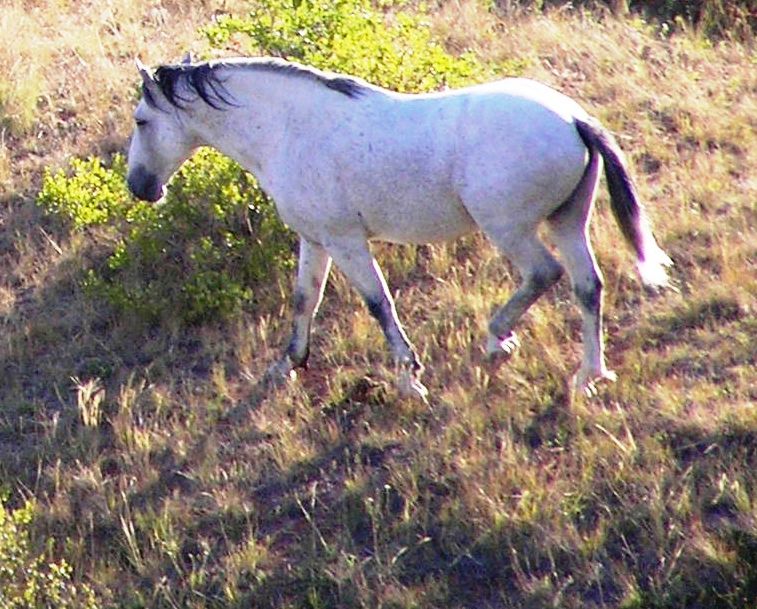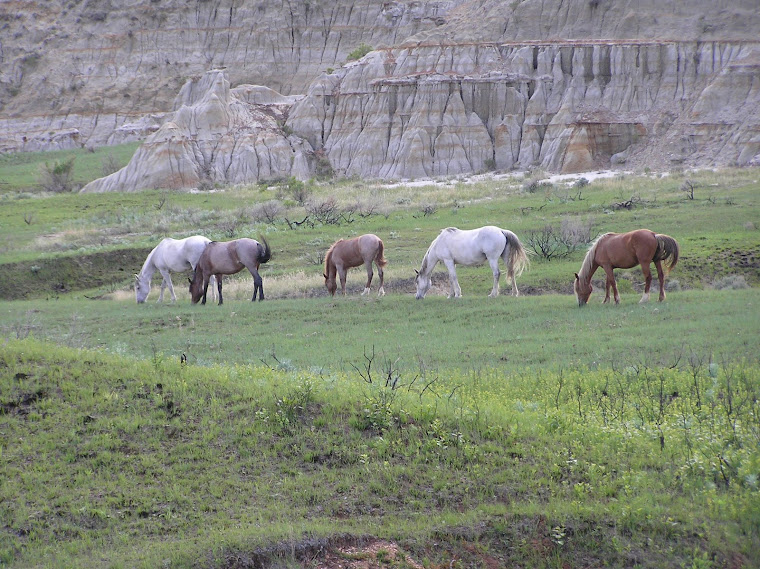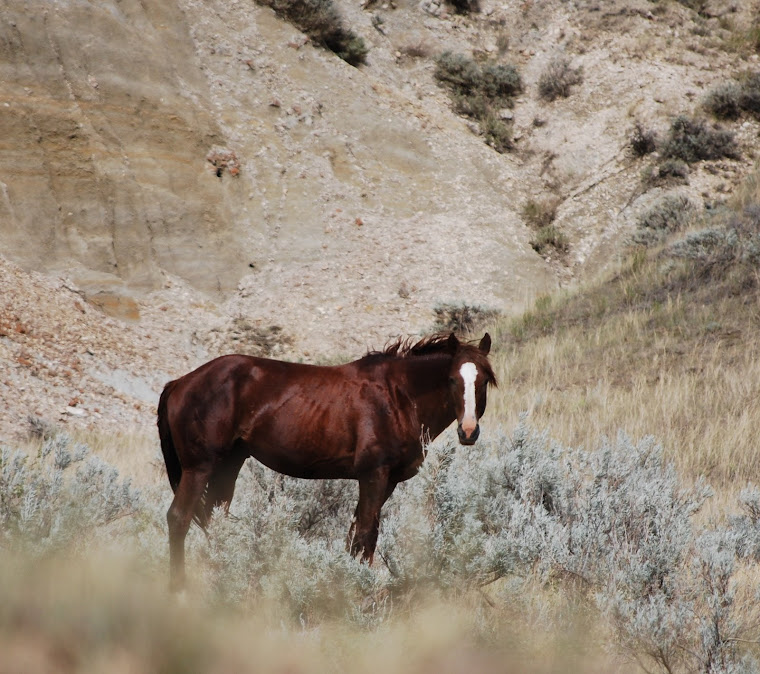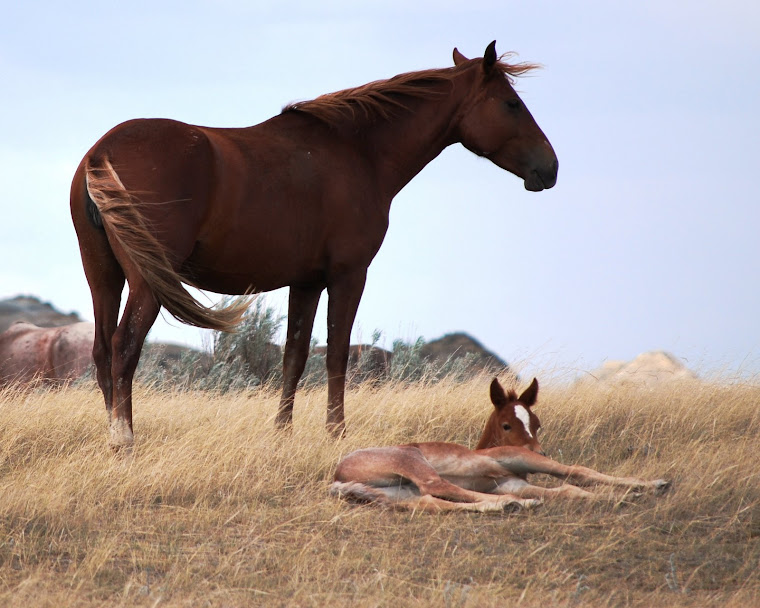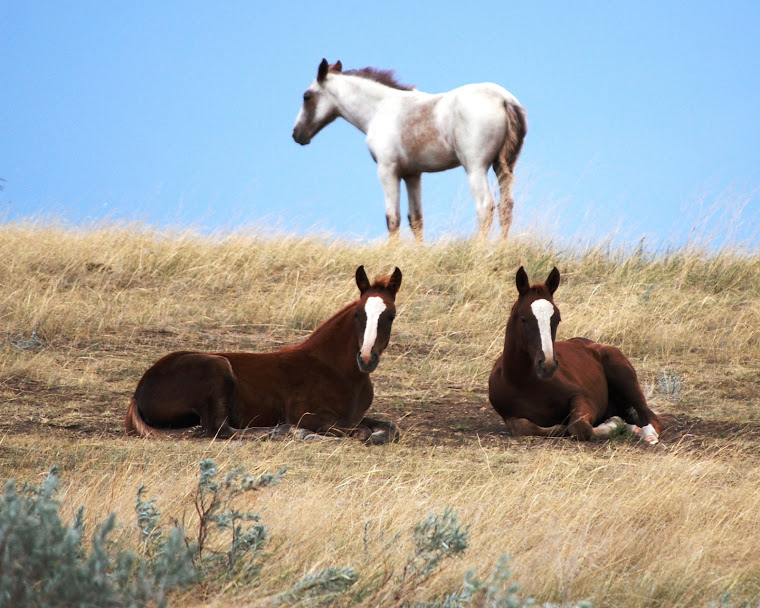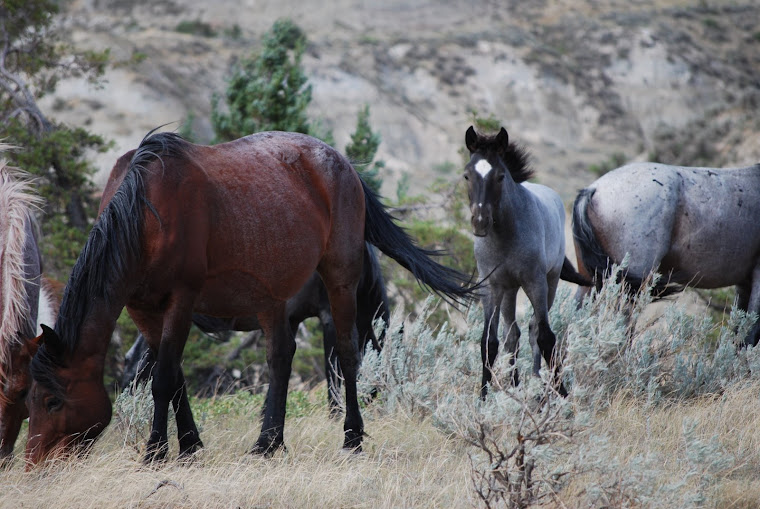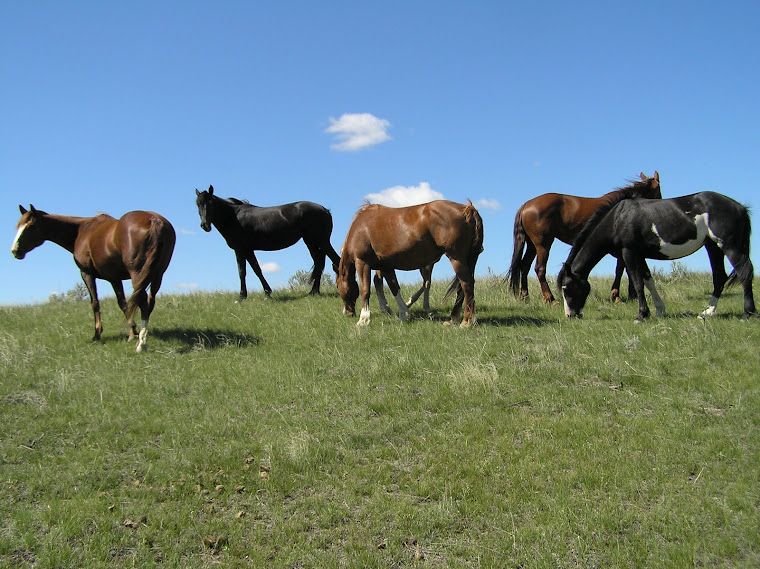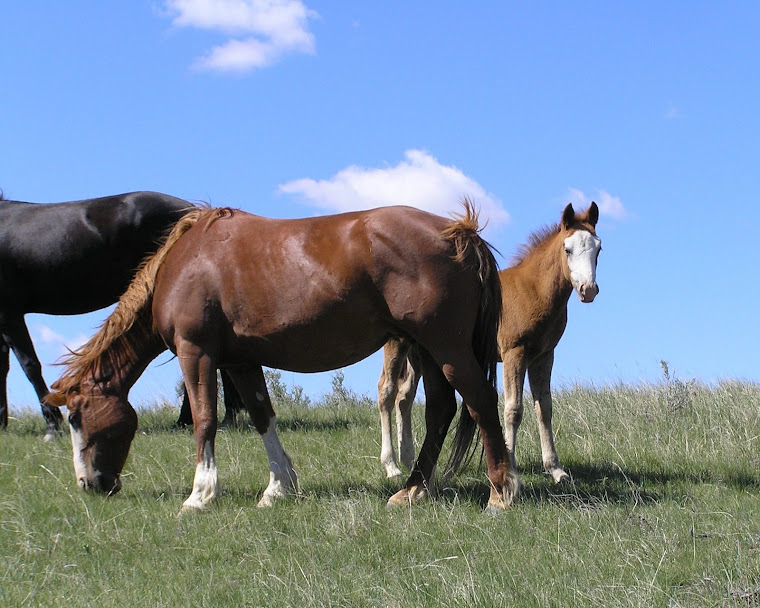Spring of 2007, a dark colt opened his eyes for the first time, blinking at the sunshine streaming down on this land of buttes, juniper lined valleys, rock encrusted ridges, and grassy meadows. Theodore Roosevelt National Park had no meaning to him; this was just his world, his home, the place he would live out his life like all the other wild horses in his little band. Little did the blue colt know that his life would not be so simple, but for now he was intent on the only goal he must accomplish, standing up to nurse. His very first steps in life were pivotal in his survival. Stand and wobble on uncooperative legs to the sweet life-giving milk the pretty gray mare standing over him was patiently offering, or fall back to the ground, too weak to rise, succumb to the cold wind, and die. The dark colt took his first steps, reached his goal, drank in life, and grew in strength.
The first two weeks of a foal's life are tenuous with predators wanting to feed on their tender flesh and other stallions with flailing feet and biting teeth attempting to steal their dams during the foal heats. The land that provides shelter and nourishment to the band can be dangerous to foals running precariously on spindly legs through deep spring snow, hidden sink holes, and rocky gullies. Around 30% of newborn foals die in the first two weeks of life, but the blue colt was one of the lucky ones. With each day he grew stronger, soon adding bright green grass to his diet of milk.
Some time during his gestation, his dam, Winter, another cute red roan, maiden mare, Little Brother's Girl, and another gray mare, Rain, with her two fillies, were stolen from his sire, Thunder Cloud. Thunder Cloud had most likely been injured in the fight with Blaze, as he was now running with another bachelor, Copper, while he gained strength to fight again. The mares stayed several months with the feisty bay roan stud, Blaze, but by spring, his blue roan sire had gained enough strength to win them back. Unfortunately for the blue colt, at one year old, he was now also considered a threat and Thunder Cloud chased him away from the band before the blue colt could learn the ways of a wild stallion from his majestic sire.
The colt didn't have much choice but to join another young stallion who had been fiercely driven from his natal band. Though he was curious when he saw us, the two leggeds he would come upon on a regular basis, he was young and shy, and didn't want to get too close to us. He would hide behind the older, braver, bald faced colt. The bald faced black colt was a son of High Star out of the beautiful gray mare, Bella. His family had been taken by Embers, so he too needed company. We called the black, Baldy and the blue, Bashful, because of his shy behavior. It was already apparent that both would gray like their dams, though both had colored sires. They spent that summer and the next munching on the rich green grass and playing with other young stallions in the "bachelor" bands. The younger bachelors were often referred to as the "young guns" because they cruised the Park play fighting and looking for mischief. It was an idyllic life for a young horse; the valleys were filled with lush grass, water was abundant, and the young Bashful had not matured enough to worry about acquiring a band of his own. However, on a rainy day in October, life took another change for Bashful, forcing him to make another choice and another step into an unknown world
The helicopters hung low in the sky that day because of the overcast sky. As they came closer, the young stallions became frightened and started to run away from them. They could already see the forms of other horses moving away in the distance, up, out of the flats and onto Boicourt Ridge, then down again into Talkington valley. Though the helicopters were a constant reminder, looming behind with their rhythmic roaring, thumping like the heart in Bashful's chest, they didn't get too close, so the horses settled into a comfortable trot that was easy for the suckling foals who had joined them along with their dams. Most of the mares moved obediently up the trail toward the east ridge, not wanting to challenge the throbbing beasts above them. One pretty, light red roan mare, Pale Lady, was not to be intimidated; finding just the right gully to make her move, she suddenly broke from the herd and led her golden dun colt, Marquis, to safety. The pilots saw her go and one attempted to go after her, but not wanting to lose the others, they let her return to freedom. Along with several other wild horses, Bashful ran into the catch pen and into another chapter of his life.
The trip though the handling facility can be very frightening, but the Park people stayed quiet and as gentle as they could be to move the horses, one at a time, through the chutes. Bashful was so distracted by all the sights and sounds above the chute as he was weighed and measured that he barely felt the needle as Doc expertly drew blood for a Coggins test. All Bashful wanted was to get out of this tight spot; he hated being confined by the high solid walls and tried to focus on the blue sky ahead of him. It must have seemed like an eternity to him, but he was soon released to run down the ally to a large pen where his buddy, Baldy, was already munching on grass. They spent three days in the large wooden pen. The green grass soon turned to brown as their sharp hooves churned it into mud. They were given fresh hay, which was difficult to learn how to eat, but filled their nervous stomachs. Water was provided from a tank that they soon learned would not hurt them. They must have wondered what would happen next.
The horses destined for sale did not have long to wait; soon large trucks came and they were herded onto the noisy, smelly stock trailers. What was more frightening was the fact that they moved under the horses' feet. The rocking and bumping must have seemed to never end, but before long they were unloaded at the sales barn in Dickinson. Nothing could have prepared these wild horses for the noise and stress of sales day with hundreds of people flocking through the alleys to gaze at the horses and plan their purchases. Bashful was particularly nervous, as he hated confinement; his only comfort were his buddies in the pen with him. On October 23, 2009 Bashful made another step that would be pivotal to his survival.
Stepping into the sales ring itself, he moved around in a daze with all the noise and lights confusing him. He could see what seemed to be hundreds of the two legged creatures surrounding him and two in particular, flailing flags at him. He couldn't get his bearings; where were his buddies; where was the light leading him out of this chaos? Then he saw it, the light of day high above him. Bashful took a huge leap in order to reach the light, a jump like he had never attempted before, to take him away from this cacophony of sounds and pressure, away to freedom. He gathered his body, tucked his front legs under his chest, rocked back on his haunches, and pushed with all the power and adrenalin within him. Up he soared toward the light, but he didn't make it to freedom; the cruel cable fence caught his hind leg and he came crashing into the crowd of people. The people screamed with fright and Bashful screamed with pain as the cable slashed into his leg. He pawed and fought furiously to get free, but it was not to be. A man under him felt his fury; a vidiographer, Brad, put himself in jeopardy and reached in to pull the man to safety; another man, Dan, threw his jacket over Bashful's head to try to calm him, but Bashful was in too much pain and terror to be calmed. He fought the jacket and anything else in reach of his teeth until his blood left crimson stains where once enthusiastic buyers had been.
What would happen to Bashful now? How would they remove him from the cable fence? Not able to watch any more, I left my safe vantage point in the auctioneer's box. Sure that they would have to euthanize him to get him off the fence, I couldn't bear to see it. As people milled around outside the barn I wondered what Bashful's fate would be inside. As the ambulance rushed away with the injured man, I learned that Bashful was removed alive from the fence and was recovering from sedation far back in the lot, away from the crowd, away from the noise, away from the auctioneer's cry as he finished the sale in the back barn. I could hardly be happy for Bashful, since he had decided his fate when he took that leap. Injured and deemed a rogue, no one would want to take him home now.
At that instant, Michael Sparling, who I had known since he was a little kid, son of our good friends, a Parelli Professional trainer, came to me and said, "I want that horse!" I was a little taken aback and just said I didn't know if they would sell him right away but to go for it. When the decision was made to sell him, Michael stepped in and bought Bashful for $35. Michael had now made a step that would forever save Bashful from certain death. Michael had seen in him a challenge to turn a horse others had rejected into one others would one day admire. Since Michael was taking on a new job in Washington state and Bashful was too injured to travel, it was decided to leave him with Michael's dad, Dan, in Bismarck. Michael spent a little time, even one night, with Bashful before his job took him to Seattle. It must have been sad to leave the nervous, blue colt behind.
It happened that Dan was also a Parelli Natural Horsemanship trainer and, having wanted to buy one of the wild ones himself, he couldn't resist starting to see what he could do with Bashful. Since Bashful was injured and Dan had injured his foot, his first tactic was to just sit outside the pen. Little by little and with generous use of treats, Dan was able to win Bashful over. He broke goals down into simple steps Bashful could understand and rewarded him for the right reactions.
With Dan's patience he gained Bashful's trust to the point of giving every part of his body up to be petted and scratched. Like other TRNP horses removed that fall, Bashful had winter ticks and loved to be scratched where they had been feeding on him. This became a way to keep Bashful coming back for attention. The scratching led to playing confidence building games, which led to under saddle training.
Over the summer Bashful became more and more reliable as a saddle horse. October 22, 2010 Dan rode Bashful back into the park. Bashful stepped with confidence onto the sun flooded ground where he was born, into the juniper lined valleys, across the rock strewn ridges, up the high buttes, and down the grassy meadows. He is in Dan's "herd of two" now and his future is bright.
Wednesday, October 27, 2010
Tuesday, October 26, 2010
MORE TRAINING FOR HAWK
It is now October of 2010, one year after the horses of Theodore Roosevelt National Park were rounded up, separated, and 77 sold at public auction. Unfortunately, we have lost track of some of them, but many of their owners are keeping in contact with us and telling us how well the horses are doing.
I will be telling the stories of some of these other horses in future blogs. One of special interest is Bashful, the horses who leaped out of the sales ring in Dickinson, but before I tell his story, let me continue Hawk's tale of progress.
As I related in the last post, Hawk is learning to be brave by playing with all the obstacles I have set up for him in the arena. Besides the can and bottle box, the bridge, the rubber tub, feed sack, and step stool, he has learned to jump over a rail and back through cones. Each new thing become easier as he gains confidence, though the tarp on the ground is still a little frightening to him. We are still working toward loading into the two-horse trailer too. He happily loads and backs out of the stock trailer, but the other one is much more enclosed. I have no doubt that he will be fine with the two-horse once he gets used to it, since he seems to be OK with almost anything once he has a chance to check it out.
Two big steps that he has taken recently are letting the farrier trim his feet and wearing a saddle. With gradual, patient, calm work, Hawk got to where I could handle his rear feet. It was hard for me, because I didn't want to take a chance of being kicked, but I had to stuff the fear deep inside and portray only confidence and trust as I asked for each foot. He has only had the farrier trim him twice since the time of his gelding, and both times he has stood quietly once the farrier pets him a little and shows him he's a friend.
After wearing the surcingle several times, the English saddle was easy. I was able to get him to smell of it and just placed it on him back. So far, the stirrups are tied up, but shortly he will learn to carry a western saddle with the stirrups flapping. I'm quite sure it won't be a big deal to him because he had carried the surcingle around the round pen with the saddle blanket flapping in the wind and he has not minded it. Those of us who are training these horses have found that they are very tolerant when introduced to new things patiently.
I am anxious to be able to ride Hawk next year, once he turns three. He has become such a willing partner who responds with he slightest cue. I have no doubt that his responsiveness with carry over into his under-saddle work and he will continue to be a joy to work with through the coming years.
See photos belo w post
I will be telling the stories of some of these other horses in future blogs. One of special interest is Bashful, the horses who leaped out of the sales ring in Dickinson, but before I tell his story, let me continue Hawk's tale of progress.
As I related in the last post, Hawk is learning to be brave by playing with all the obstacles I have set up for him in the arena. Besides the can and bottle box, the bridge, the rubber tub, feed sack, and step stool, he has learned to jump over a rail and back through cones. Each new thing become easier as he gains confidence, though the tarp on the ground is still a little frightening to him. We are still working toward loading into the two-horse trailer too. He happily loads and backs out of the stock trailer, but the other one is much more enclosed. I have no doubt that he will be fine with the two-horse once he gets used to it, since he seems to be OK with almost anything once he has a chance to check it out.
Two big steps that he has taken recently are letting the farrier trim his feet and wearing a saddle. With gradual, patient, calm work, Hawk got to where I could handle his rear feet. It was hard for me, because I didn't want to take a chance of being kicked, but I had to stuff the fear deep inside and portray only confidence and trust as I asked for each foot. He has only had the farrier trim him twice since the time of his gelding, and both times he has stood quietly once the farrier pets him a little and shows him he's a friend.
After wearing the surcingle several times, the English saddle was easy. I was able to get him to smell of it and just placed it on him back. So far, the stirrups are tied up, but shortly he will learn to carry a western saddle with the stirrups flapping. I'm quite sure it won't be a big deal to him because he had carried the surcingle around the round pen with the saddle blanket flapping in the wind and he has not minded it. Those of us who are training these horses have found that they are very tolerant when introduced to new things patiently.
I am anxious to be able to ride Hawk next year, once he turns three. He has become such a willing partner who responds with he slightest cue. I have no doubt that his responsiveness with carry over into his under-saddle work and he will continue to be a joy to work with through the coming years.
See photos belo w post
Friday, July 23, 2010
THE SIGNIFICANCE OF A NAME by Bonnie Overby

"Why can't you be like other women and prefer diamonds over horses?" This was Soldier Man's response from half way around the globe in Afghanistan when he learned that I had, indeed, purchased a wild horse.
Earlier, our grown daughter had accurately remarked, "Dad won't be happy, but he won't be surprised either."
"Well, I guess this will have to be both your birthday and Christmas present, " he said, knowing that my birthday had been the day before and that no gift was in the mail. My husband has always had trouble buying me gifts, probably because I don't feel the need for traditional stuff women like to receive.
Enthusiastically I replied, "This is a wonderful gift; thank you so much!"
I could hear the softening in his voice when he said, "Well, it's going to have to be your birthday present, anyway."
"Just be thankful it's a wild horse I'm chasing and not wild men!" I grinned over the phone.
When Soldier Man left for his one year tour of duty in Afghanistan, my friend, Mya, took it upon herself to make sure I would not sit home and sulk. Weather permitting, the two of us were off riding our horses whenever schedules and family allowed us to get away. During the summer, I noticed in an equine paper that there was going to be a wild horse auction in the fall some time. I called up Mya, "Mya, please convince me that I should not go to this auction."
"I think it's a great idea! That will be my birthday present to you."
Okay, it didn't take much to convince me, but we were going to leave the trailers at home. We eagerly waited for it to be announced when the auction would be. October 23rd, the day before my birthday, I arranged for a replacement at work for that weekend. " Remember, we're not taking a trailer with us, Mya, this is just a fun get-away weekend, we'll think of it as entertainment. Together, we could not think of a better way to spend a weekend.
"Bonnie, I'm hauling my trailer down. I know you, you'll buy a horse and I'll have to come all the way home and back again to get it. Besides, even if you don't buy one, maybe I can help someone else out by hauling for them."
We got to the auction ring several hours before the start of the sale. We carefully looked over each pen, made notes of horses we would like to own, visited with other enthusiastic and curious onlookers, and marveled at the unique colors represented by the herd. Could we manage one of these beautiful bachelor stallions and did we have the appropriate area for them? It was a no-brainer that we would be taking a least one apiece home, if not more, but decided we probably should stick with one of the younger horses.
We sat in the crowded arena nervous and excited for the bidding of the wild horses to start; we had an opportunity to take home a registered Quarter Horse weanling for next to nothing, but we wanted one of the mysterious, often forbidden animals that we had viewed from a distance in the Park. The bidding was competitive, and we realized , if we were serious, we would need to spend more than we initially planned, if the dreams we had formed were to come true. In the end, Mya purchased Cinnamon, a one year old pretty little sorrel as well as a weanling filly, Lindbo, a five month old gray overo filly with one blue eye, neither of which had been on our list to buy. I purchased number 364, Sugar, a red roan yearling that reminded me of a filly I had owned and lost to colic.
These horses were raw beauties that we felt honored and a little scared, for more than one reason, to be taking home. Nightfall had come but in our excitement we had no problem staying awake on the long drive home. We strategically planned how we would house these horses and honor our commitment to care for them, these powerful creatures that had neither known barriers nor the gentle touch of human hands. We wondered and laughed over what we had gotten ourselves into this time.
"Do you realize, Mya, that we purchased Cinnamon and Sugar?" We hadn't until this moment in our drive home. We both knew coincidences didn't happen without reason. "It was meant to be!"
When the North Dakota Badlands Horse Registry was up and running, I wanted to choose a name that reflected my horse and the significance of the event. I wanted to keep her Park name and chose "Autumn" to reflect one of the best birthday events ever, and "Diamond" in remembering the conversation with my husband. Thus "Autumn's Sugar Diamond was formed.

Afterward: My husband recently returned from Afghanistan. He was pleasantly surprised that my wild horse didn't seem wild at all. One of his concerns for me was that I would get hurt working with her. I found this very sweet since this was the first time in 27 years that he had voiced worry about me getting hurt around horses.
Monday, June 7, 2010
THE FERAL HORSE STUDY AT TRNP - YEAR 2
Wow, where do I start to report on the study? We have been so busy working there and working with our youngsters here at home that I have not had time to write about it. We are now over half done with the study this season and have had many interesting experiences with the wild ones. Mike started doing observations of the bands in early April. By the second week, Henry and I and our new Horse Project Technicians, Heidi, from Chicago, and Al, a local retired rancher, had joined him and were covering the park on foot and on horseback. Two more, Veterinary students from Colorado State, joined us in mid May. Alanna and Lindsey will work full time with Heidi, while Al, Henry, and I will work part time.
This year, besides the location, weather conditions, names and number in the band, 20 minute activity log, spatial chart, and all occurrence activity log, each mare will be evaluated once per week for body condition, injection site reactions, and expected date of foaling. New foals are reported as soon as they are found so that foal heats and next year's foaling dates can be calculated. Fortunately, we have not seen anything to indicate that foals of the treated mares are any less viable. The harsh winter and normal breeding activities of the horses have contributed to some foal mortality in the first 2 weeks of life, but is to be expected in a wild herd of this size. As of June 4 we had 27 live foals and had lost 6. We fully expect to lose a few more, as in that first 2 weeks, many perils face the delicate young foals; once the foal is stronger and has weathered it's dam's foal heat, it usually does well.
I do not have good photos of all the foals yet, because new moms are not very willing to share their new babies with anyone, but I will list the mares and their foals here and add as many photos as I can at the bottom of the blog.
In Little Sorrel's band we have three new fillies: Trouble's Girl's filly, Feather, Freckles' filly, Shawl, and Little Gray's filly, Dream.
Red Face has Molly with a filly, Dove, Flame with a filly, Bandanna, and Pretty Girl with a filly, Papoose. Singlefoot has Frosty with a colt, Wrangler, Lightning with a filly, Latigo, and Crow with a filly, Eagle. Eagle had not been seen the day after we found her.
Wind Canyon has a filly, Chaps, out of Betty Blue.
Embers has a colt, Arrowhead, out of Bella.
Blaze has a filly, Sky, out of Little Brother's Girl and a colt out of Domino. We fear the colt is a lethal white so may not live long.
Cocoa has a filly, Maiden, out of Busy Blue and a colt, Brave, out of Autumn. Stormy lost a filly that looked just like Cocoa Puff from last year.
Sidekick has a colt, Peace Pipe, out of Snip's Gray, a colt, Guitar, out of Embers' Girl and another colt, Stetson, out of Orphan Blue.
Mystery has a colt, Half Moon, out of Lacey and a filly, Tepee, out of Shale.
Copper has a colt, Wing, out of Angel, and a filly, Cowgirl, out of Bentonite. Both foals should be by the black stallion who died last summer, High Star.
Gary has a cute filly out of Twister, named Dancer.
Brutus has Tomahawk, a colt out of Maddie by Silver.
Thunder Cloud has a filly out of his mare, Winter, named Boots and and colt (we think) out of Pale Lady and High Star, named Reata.
We have seen some interesting and even surprising behavior out of the horses, but the most surprising happened June 2. Henry and I walked out to Sheep Butte because it had rained that morning and spoiled our plans to ride. We came upon Cocoa, Blaze, Red Face, Singlefoot and his "body guard" Satellite, Brutus, and Copper all on the flats below us. As we did our observations on Cocoa and his band, they climbed the steep side of Sheep Butte. We worked the double band of Red Face and Singlefoot next, keeping a close eye on Crow, who had just foaled and was being guarded by Satellite. He was trying to herd her closer to the double band while protecting her from Blaze. She would have none of it and just wanted to be left alone. Satellite's attempts to herd her met with kicks and constant circling of the new foal. As the double band moved farther to the north, he finally got her to move closer to them, but then she was too close and he prevented her from joining them.
While this was going on, Blaze also moved farther north, so we walked out along the top of the butte, around Cocoa's band now standing on top, and settled in on a ledge overlooking the whole of Lindbo Flats. While working Blaze, Brutus, and Copper's bands, Satellite continued to try to get Crow to follow the double band. Twice Blaze went out to challenge him, both stallions sniffing, posturing, squealing, stomping and spinning away with a kick. Crow was at last left at peace along the fence with Satellite, a little frustrated, still standing guard. Then, with Blaze and Brutus with easy access to Crow, Satellite took off the follow the double band, his need for his familiar place in their band overcoming his desire to keep a mare. Surprisingly, both Brutus and Blaze moved off and left poor, tired, Crow alone.
As we were busily working all the bands before us and starting the last band, Copper, I picked up the phone to call Al and let him know what bands we had finished. Having a hard time getting good signal on my cell phone, I turned my head to the right and caught a glimpse of a horse close behind me-very close. I dropped the phone as I turned to see Cocoa and all his band standing in a semi-circle about 20 feet from us. We had been so busy we didn't see or hear them coming, but now it seemed that had those pesky humans where they wanted them. It almost seemed that they wanted to push us off the ledge, but of coarse they didn't. They were just curious as to what we were doing. While we finished our observation of Copper they settled in to rest, the babies stretching out to soak up the warm sun.
I suggested we do another observation on them since Stormy should have been on the first day of her foal heat. Henry didn't even get his cover sheet completed before Cocoa started to show interest in Stormy. We watched in amazement as Cocoa courted Stormy with soft nickers and touches. While standing 12 feet from us he completed the breeding. We were a little concerned that they would run right into us, but they politely finished and went on to feeding. We had been wondering whether we should slide off the ledge, but we didn't want to miss any of the action, so I continued to snap pictures through the whole event. The only problem was that they were so close that I couldn't get much in my lens, but I have the photos to prove another amazing tale of the wild horse of TRNP.
This year, besides the location, weather conditions, names and number in the band, 20 minute activity log, spatial chart, and all occurrence activity log, each mare will be evaluated once per week for body condition, injection site reactions, and expected date of foaling. New foals are reported as soon as they are found so that foal heats and next year's foaling dates can be calculated. Fortunately, we have not seen anything to indicate that foals of the treated mares are any less viable. The harsh winter and normal breeding activities of the horses have contributed to some foal mortality in the first 2 weeks of life, but is to be expected in a wild herd of this size. As of June 4 we had 27 live foals and had lost 6. We fully expect to lose a few more, as in that first 2 weeks, many perils face the delicate young foals; once the foal is stronger and has weathered it's dam's foal heat, it usually does well.
I do not have good photos of all the foals yet, because new moms are not very willing to share their new babies with anyone, but I will list the mares and their foals here and add as many photos as I can at the bottom of the blog.
In Little Sorrel's band we have three new fillies: Trouble's Girl's filly, Feather, Freckles' filly, Shawl, and Little Gray's filly, Dream.
Red Face has Molly with a filly, Dove, Flame with a filly, Bandanna, and Pretty Girl with a filly, Papoose. Singlefoot has Frosty with a colt, Wrangler, Lightning with a filly, Latigo, and Crow with a filly, Eagle. Eagle had not been seen the day after we found her.
Wind Canyon has a filly, Chaps, out of Betty Blue.
Embers has a colt, Arrowhead, out of Bella.
Blaze has a filly, Sky, out of Little Brother's Girl and a colt out of Domino. We fear the colt is a lethal white so may not live long.
Cocoa has a filly, Maiden, out of Busy Blue and a colt, Brave, out of Autumn. Stormy lost a filly that looked just like Cocoa Puff from last year.
Sidekick has a colt, Peace Pipe, out of Snip's Gray, a colt, Guitar, out of Embers' Girl and another colt, Stetson, out of Orphan Blue.
Mystery has a colt, Half Moon, out of Lacey and a filly, Tepee, out of Shale.
Copper has a colt, Wing, out of Angel, and a filly, Cowgirl, out of Bentonite. Both foals should be by the black stallion who died last summer, High Star.
Gary has a cute filly out of Twister, named Dancer.
Brutus has Tomahawk, a colt out of Maddie by Silver.
Thunder Cloud has a filly out of his mare, Winter, named Boots and and colt (we think) out of Pale Lady and High Star, named Reata.
We have seen some interesting and even surprising behavior out of the horses, but the most surprising happened June 2. Henry and I walked out to Sheep Butte because it had rained that morning and spoiled our plans to ride. We came upon Cocoa, Blaze, Red Face, Singlefoot and his "body guard" Satellite, Brutus, and Copper all on the flats below us. As we did our observations on Cocoa and his band, they climbed the steep side of Sheep Butte. We worked the double band of Red Face and Singlefoot next, keeping a close eye on Crow, who had just foaled and was being guarded by Satellite. He was trying to herd her closer to the double band while protecting her from Blaze. She would have none of it and just wanted to be left alone. Satellite's attempts to herd her met with kicks and constant circling of the new foal. As the double band moved farther to the north, he finally got her to move closer to them, but then she was too close and he prevented her from joining them.
While this was going on, Blaze also moved farther north, so we walked out along the top of the butte, around Cocoa's band now standing on top, and settled in on a ledge overlooking the whole of Lindbo Flats. While working Blaze, Brutus, and Copper's bands, Satellite continued to try to get Crow to follow the double band. Twice Blaze went out to challenge him, both stallions sniffing, posturing, squealing, stomping and spinning away with a kick. Crow was at last left at peace along the fence with Satellite, a little frustrated, still standing guard. Then, with Blaze and Brutus with easy access to Crow, Satellite took off the follow the double band, his need for his familiar place in their band overcoming his desire to keep a mare. Surprisingly, both Brutus and Blaze moved off and left poor, tired, Crow alone.
As we were busily working all the bands before us and starting the last band, Copper, I picked up the phone to call Al and let him know what bands we had finished. Having a hard time getting good signal on my cell phone, I turned my head to the right and caught a glimpse of a horse close behind me-very close. I dropped the phone as I turned to see Cocoa and all his band standing in a semi-circle about 20 feet from us. We had been so busy we didn't see or hear them coming, but now it seemed that had those pesky humans where they wanted them. It almost seemed that they wanted to push us off the ledge, but of coarse they didn't. They were just curious as to what we were doing. While we finished our observation of Copper they settled in to rest, the babies stretching out to soak up the warm sun.
I suggested we do another observation on them since Stormy should have been on the first day of her foal heat. Henry didn't even get his cover sheet completed before Cocoa started to show interest in Stormy. We watched in amazement as Cocoa courted Stormy with soft nickers and touches. While standing 12 feet from us he completed the breeding. We were a little concerned that they would run right into us, but they politely finished and went on to feeding. We had been wondering whether we should slide off the ledge, but we didn't want to miss any of the action, so I continued to snap pictures through the whole event. The only problem was that they were so close that I couldn't get much in my lens, but I have the photos to prove another amazing tale of the wild horse of TRNP.
Sunday, April 4, 2010
MORE DANCING WITH HAWK
Hawk is a master at the dance, an attentive, respectful gentleman, graceful yet powerful, wary yet trusting.
It's hard to explain just how much Hawk has worked his way into my heart. Seeing him slowly learning that he can look to me for security and leadership even though his instincts tell him to run from me, builds my respect and appreciation of him more and more every day. He will always have a special place in my heart and I look forward to the day that I can ride him back in the park where he once ran free. What a wonderful privilege that will be for all of us who have taken home one of these very special horses.
The weather and melting snow made it impossible to keep Hawk and Hail outside, so Henry built me a small round pen inside the barn that is accessible from the stalls. Since both horses had been loading in and out of the trailer for several weeks, it was no problem to get them loaded for the short trip to the barn. Now they have an outside pen, nice dry stalls in the barn, and the little round pen to play in. I was afraid Hawk would be more skittish inside the barn because of all the stuff, the sound of the tin roof, and the cats running everywhere, but he has actually been more relaxed. He will flinch if a cat jumps onto the plastic bedding bags we have strewn around outside the round pen, but he stands his ground.
In the five months I have been working with Hawk, I have been so amazed with his intelligence and his willingness to do whatever it is I ask of him, even though it is against his instincts. We are perfecting our games every day. He now lets me touch him with ropes, towels, blankets, plastic, nylon, etc. He is so attentive and sensitive that the slightest cue of touching just the hair of his side sends him away from the pressure in a pivot on the forehand. I only have to point in the direction I want him to go to get him to circle the pen or reverse directions and a wagging finger backs him up. He's not brave enough to step on the blanket on the floor yet, but he will approach, sniff, and chew it.
After all these months of working on trust, he will finally let me rub inside and out on all four legs. Though he immediately puts it down again, I can get him to lift any foot just by touching it and telling him, "Up." Earlier in his training, he was so extremely afraid of the thicker ropes. I think he really thought they were snakes, because he would let me touch him all over with the lariat or the lash of the training stick, but he would cringe when I touched him with the lead rope. Now he lets me touch him all over with it and a long soft cotton rope that I use to work with his feet. Once I was able to touch him with the cotton rope, I could reach around a leg to make a loop around it. By twisting the long ends together, I could keep the loop around the pastern and ask him to lift the leg. That way he learned to lift the foot without my having to get too close to it. I also use this method to get him used to having a leg restrained. I wrap the rope around a pastern and then ask him to move around the pen. When I say, "Whoa," I put pressure on the rope and I don't release him until he stops dead still. I thought that would really panic him, but he didn't panic and learned quickly to stop and stand.
He has learned to give to the pressure of the halter when I wrap the rope around his hind quarters and ask with the rope for him to make a complete 360. In preparation for vaccinations, he is learning to relax his neck when I pinch on his neck and poke him with a blunt substitute needle. I hope it works! We are about 10 days from "G day" so we are having friends come and pretend to be the vet. We have decided to have the vet come here so that we don't have to put Hawk though the trauma of the vet clinic until he has had more experience outside his little world of our barnyard.
Hawk has a long way to go to be trusting of all his two-legged friends, but he now comes to me and drops his head letting me know he wants to be near me and get the scratches he's learned to love. I couldn't ask for a more engaging dance partner. Who needs Dancing with the Stars when I can dance with a Hawk!
It's hard to explain just how much Hawk has worked his way into my heart. Seeing him slowly learning that he can look to me for security and leadership even though his instincts tell him to run from me, builds my respect and appreciation of him more and more every day. He will always have a special place in my heart and I look forward to the day that I can ride him back in the park where he once ran free. What a wonderful privilege that will be for all of us who have taken home one of these very special horses.
The weather and melting snow made it impossible to keep Hawk and Hail outside, so Henry built me a small round pen inside the barn that is accessible from the stalls. Since both horses had been loading in and out of the trailer for several weeks, it was no problem to get them loaded for the short trip to the barn. Now they have an outside pen, nice dry stalls in the barn, and the little round pen to play in. I was afraid Hawk would be more skittish inside the barn because of all the stuff, the sound of the tin roof, and the cats running everywhere, but he has actually been more relaxed. He will flinch if a cat jumps onto the plastic bedding bags we have strewn around outside the round pen, but he stands his ground.
In the five months I have been working with Hawk, I have been so amazed with his intelligence and his willingness to do whatever it is I ask of him, even though it is against his instincts. We are perfecting our games every day. He now lets me touch him with ropes, towels, blankets, plastic, nylon, etc. He is so attentive and sensitive that the slightest cue of touching just the hair of his side sends him away from the pressure in a pivot on the forehand. I only have to point in the direction I want him to go to get him to circle the pen or reverse directions and a wagging finger backs him up. He's not brave enough to step on the blanket on the floor yet, but he will approach, sniff, and chew it.
After all these months of working on trust, he will finally let me rub inside and out on all four legs. Though he immediately puts it down again, I can get him to lift any foot just by touching it and telling him, "Up." Earlier in his training, he was so extremely afraid of the thicker ropes. I think he really thought they were snakes, because he would let me touch him all over with the lariat or the lash of the training stick, but he would cringe when I touched him with the lead rope. Now he lets me touch him all over with it and a long soft cotton rope that I use to work with his feet. Once I was able to touch him with the cotton rope, I could reach around a leg to make a loop around it. By twisting the long ends together, I could keep the loop around the pastern and ask him to lift the leg. That way he learned to lift the foot without my having to get too close to it. I also use this method to get him used to having a leg restrained. I wrap the rope around a pastern and then ask him to move around the pen. When I say, "Whoa," I put pressure on the rope and I don't release him until he stops dead still. I thought that would really panic him, but he didn't panic and learned quickly to stop and stand.
He has learned to give to the pressure of the halter when I wrap the rope around his hind quarters and ask with the rope for him to make a complete 360. In preparation for vaccinations, he is learning to relax his neck when I pinch on his neck and poke him with a blunt substitute needle. I hope it works! We are about 10 days from "G day" so we are having friends come and pretend to be the vet. We have decided to have the vet come here so that we don't have to put Hawk though the trauma of the vet clinic until he has had more experience outside his little world of our barnyard.
Hawk has a long way to go to be trusting of all his two-legged friends, but he now comes to me and drops his head letting me know he wants to be near me and get the scratches he's learned to love. I couldn't ask for a more engaging dance partner. Who needs Dancing with the Stars when I can dance with a Hawk!
Saturday, February 27, 2010
TRAINING UPDATE
Once both horses had been touched, scratched, and knew that we meant them no harm, it was time to expect more. I realize that many trainers take these steps much faster, but, though winter provides a longer period of time to accomplish the gentling process, it is wrought with obstacles that hamper, disrupt, and delay the work. Our horses are outside where we do not have the best footing and the weather in North Dakota can be down right frustrating when the temperatures hover around zero for weeks at a time. We've had to make the best of the conditions we've had in training these colts.

Hails remains my high achiever. Hail puts up with just about anything as long as it means he can stand and get petted. Whether it's a brush, a halter, a lariat, or a saddle blanket, he enjoys getting rubbed with it. He wore his blanket around the pen and wasn't too concerned about it flapping in the wind. So tolerant about letting me handle his feet, he let us trim his front feet today. I wouldn't say he leads well yet, but he's getting the hang of it. I think he is coming along very well since I really haven't spent that much time with him and the icy footing has made it dangerous to move him around a lot.
It's good that I have a more challenging colt, because he gives me something to write about on this blog. I've taken this gentling process more slowly with Hawk as well as Hail, partly because of the icy footing, and partly because getting him drenched with sweat from running around the pen would put him in danger of getting sick. Hawk has made steady progress, but he struggles with controlling his fear. Though he thoroughly enjoyed my scratching him from head to tail, he could only control his fear so long before he would leap away without warning. I was very aware of the need for me to release him often for every submission, but it was three months and he was still jumping away without any noticeable change in my activity. Luckily Hawk knows from the work I have been able to do with him that he is supposed to face me, so rather than run away he often just backs away, which allows me to chase him around backward. Backing is slower but much more work than running forward, so it is safer and an even harder penalty for not overcoming his fear and trusting me.
Still needing some fresh ideas of how to speed the process along, I went to a colt starting demonstration by Ken McNabb at our Ag Days in Bismarck. They finally found a tough colt for him, so it was interesting to see how Ken adapted his approach to fit the colt and the facility. Since the colt wanted to jump out of the pen into the crowd at the Civic Center, Ken was not able to move him around as he had planned; he quickly went to plan B and roped him. With that additional control Ken could keep the colt and the crowd safe. As he worked the colt to the point of having him ready to ride, I realized that the rope would be a good tool for me to use in helping Hawk face his fears. One small hitch was that I don't rope and didn't even have a decent one. No problem! Going to one of the local tack shops, I asked for a "Rope for Dummies." Chip suggested a used one and showed me a box full of them. Using my trained eye, I looked for the perfect lariat that would change this dressage rider into a roper. Actually, I just picked a green one because it was prettier than the dirty white ones. I was ready for action and the next chapter in Hawk's training.
Armed with my new rope I entered the pen, pointed to the gate of the round pen, Hawk obediently trotted inside, and we were ready for our first training with the lariat. Earlier, when moving him around the pen, I had tossed the knotted end of an old rope at Hawk to get him used to having it touch him, so it wasn't so frightening to have me toss a loop at him as I moved him around the pen this time. Closing in, with my heart in my throat, I tossed a few loops from the back toward his head (so that I wouldn't crack him in the eye with my poorly thrown loop). Success!; I had the wild colt on the end of a rope, aaaaaaaah, now what would I do with him?
With the noose around his neck, Hawk took off for the other side of the pen. Wondering if I would soon become a horse powered skier in the icy pen, I set my feet and pulled the slack out of the rope. The noose tightened around his neck and Hawk swung around to face me with a rather surprised look in his eyes. After a moment of reward with a slack rope, I moved him around the pen again, told him whoa, and brought him around to face me again. After a few repetitions of moving him, asking him to stop, and bringing him around to face me with tension on the rope, we were ready to test his patience and control while standing. He let me rub him all over on the left, but was still jumpy with me on the right so he jumped away a couple times and ran backward several times, but every time he felt the noose tighten and bring him to face me. By the end of the session that day I was able to rub him all over and brush him head to tail without having him jump away. Two days later I was able to repeat the brushing with no rope and no leaping away!

Each day with the rope has brought more success in getting him to tolerate being touched with new objects, farther down each leg, and onto his face. Now if he starts to move away, I can tell him whoa and put a slight pressure on the rope; he stops. He is starting to let me lead him by putting pressure on the rope from the side; when he submits and moves toward me he is immediately rewarded with slack in the rope. Today, the fourth day with the rope, I was able to sack him out with the lariat, the halter, and a saddle blanket. Hawk still struggles with his fears, most times cringing as the blanket is tossed his way, but he is standing his ground and gaining control over his instinct to run. He is closer to being the quiet, trusting horse he is destined to be.

Hails remains my high achiever. Hail puts up with just about anything as long as it means he can stand and get petted. Whether it's a brush, a halter, a lariat, or a saddle blanket, he enjoys getting rubbed with it. He wore his blanket around the pen and wasn't too concerned about it flapping in the wind. So tolerant about letting me handle his feet, he let us trim his front feet today. I wouldn't say he leads well yet, but he's getting the hang of it. I think he is coming along very well since I really haven't spent that much time with him and the icy footing has made it dangerous to move him around a lot.
It's good that I have a more challenging colt, because he gives me something to write about on this blog. I've taken this gentling process more slowly with Hawk as well as Hail, partly because of the icy footing, and partly because getting him drenched with sweat from running around the pen would put him in danger of getting sick. Hawk has made steady progress, but he struggles with controlling his fear. Though he thoroughly enjoyed my scratching him from head to tail, he could only control his fear so long before he would leap away without warning. I was very aware of the need for me to release him often for every submission, but it was three months and he was still jumping away without any noticeable change in my activity. Luckily Hawk knows from the work I have been able to do with him that he is supposed to face me, so rather than run away he often just backs away, which allows me to chase him around backward. Backing is slower but much more work than running forward, so it is safer and an even harder penalty for not overcoming his fear and trusting me.
Still needing some fresh ideas of how to speed the process along, I went to a colt starting demonstration by Ken McNabb at our Ag Days in Bismarck. They finally found a tough colt for him, so it was interesting to see how Ken adapted his approach to fit the colt and the facility. Since the colt wanted to jump out of the pen into the crowd at the Civic Center, Ken was not able to move him around as he had planned; he quickly went to plan B and roped him. With that additional control Ken could keep the colt and the crowd safe. As he worked the colt to the point of having him ready to ride, I realized that the rope would be a good tool for me to use in helping Hawk face his fears. One small hitch was that I don't rope and didn't even have a decent one. No problem! Going to one of the local tack shops, I asked for a "Rope for Dummies." Chip suggested a used one and showed me a box full of them. Using my trained eye, I looked for the perfect lariat that would change this dressage rider into a roper. Actually, I just picked a green one because it was prettier than the dirty white ones. I was ready for action and the next chapter in Hawk's training.
Armed with my new rope I entered the pen, pointed to the gate of the round pen, Hawk obediently trotted inside, and we were ready for our first training with the lariat. Earlier, when moving him around the pen, I had tossed the knotted end of an old rope at Hawk to get him used to having it touch him, so it wasn't so frightening to have me toss a loop at him as I moved him around the pen this time. Closing in, with my heart in my throat, I tossed a few loops from the back toward his head (so that I wouldn't crack him in the eye with my poorly thrown loop). Success!; I had the wild colt on the end of a rope, aaaaaaaah, now what would I do with him?
With the noose around his neck, Hawk took off for the other side of the pen. Wondering if I would soon become a horse powered skier in the icy pen, I set my feet and pulled the slack out of the rope. The noose tightened around his neck and Hawk swung around to face me with a rather surprised look in his eyes. After a moment of reward with a slack rope, I moved him around the pen again, told him whoa, and brought him around to face me again. After a few repetitions of moving him, asking him to stop, and bringing him around to face me with tension on the rope, we were ready to test his patience and control while standing. He let me rub him all over on the left, but was still jumpy with me on the right so he jumped away a couple times and ran backward several times, but every time he felt the noose tighten and bring him to face me. By the end of the session that day I was able to rub him all over and brush him head to tail without having him jump away. Two days later I was able to repeat the brushing with no rope and no leaping away!

Each day with the rope has brought more success in getting him to tolerate being touched with new objects, farther down each leg, and onto his face. Now if he starts to move away, I can tell him whoa and put a slight pressure on the rope; he stops. He is starting to let me lead him by putting pressure on the rope from the side; when he submits and moves toward me he is immediately rewarded with slack in the rope. Today, the fourth day with the rope, I was able to sack him out with the lariat, the halter, and a saddle blanket. Hawk still struggles with his fears, most times cringing as the blanket is tossed his way, but he is standing his ground and gaining control over his instinct to run. He is closer to being the quiet, trusting horse he is destined to be.
Hawk was haltered for the first time today (3-5-10) He's pretty comfortable with it!
Thursday, February 18, 2010
WHIT AND TEDDY'S STORY


After much arm twisting and patience, I finally got our low stress livestock handler and friend, Whit, to write Teddy's story. Teddy was the blue roan yearling colt with the band of ten that Whit and I walked out of the Park in the only successful low stress roundup of wild horses ever attempted in TRNP. Thanks, Whit! (Oh, by the way, Whit did all the work; I just got to ride along :)
If you have not read Whisper's story written on this blog in September of 2008, you might want to read it to get the whole story about that low stress roundup. Teddy is Whisper's half brother and is pictured in that story.
Below is Teddy's story, written by Whit Hibbard
In May of 2008, I taught a short-course on low-stress livestock handling at Theodore Roosevelt National Park at the request of the superintendent. As part of my visit I agreed to test the principles and techniques that I taught, on the Campground Band, which the park wanted to cull.
The day after the class I went out with Marylu Weber as my photo-documentarian. Using principles and techniques of low-stress livestock handling, we easily walked the band into a portable holding pen, then loaded the horses in trailers for transport and safekeeping at the park's animal handling facility until a public auction in Dickinson.
While the horses were in the portable holding pen, I stood on the outside to get the horses accustomed to me, and a blue roan colt walked up and sniffed my outreached hand. Observing this, Marylu said, "I think you ought to buy that colt; you have him half gentled already!" In anticipation of what a time commitment it would be for me to properly care for and train the horse with my already overloaded ranch work schedule, I replied, " I think that's a dangerous idea!" Over the next few days, however, I couldn't get the idea that Marylu had planted out of my head. The truth of the matter is that I had very mixed emotions about capturing this band. On the one hand, I was elated that the principles and techniques of low-stress livestock handling had worked so well and that the horses were walked in and loaded into trailers willingly and calmly. On the other hand, I had some pangs of remorse for what I'd done, knowing that I had ripped the horses out of their native environment and drastically changed each of their lives, and some probably for the worse. At that point I decided that Marylu's suggestion was a good one and decided to buy the blue roan colt so that at least one of the horses would have a good home.
I bought "Teddy" at the public auction, shipped him home to my family's ranch in Montana, spent the next several months gentling him and gaining his trust, and engaging the services of a first-class trainer in the Californios tradition, Mike Goyins, to help me with Teddy's training. (Mike pictured riding Teddy) I mentioned to Mike that I would like to take Teddy all the way through the bridle horse stage and thought that we should make a DVD of the five year process and call it, "From Wild Horse to Bridle Horse." Mike's eyes lit up and he said, "I'm on board!"
So, as a yearling we handled Teddy a lot and went through the basic ground work. As a two year old, we reviewed all prior lessons, added a few more, and road him twice with the halter. This coming summer, 2010, we will get him in a snaffle bridle and his real education will begin, the bulk of which will be in the process of doing a job-working cattle.
Both Mike and I are exceptionally impressed with Teddy. He is smart, curious, and a willing learner. We both believe that he will make a fine bridle and ranch horse.
Sunday, January 24, 2010
THE DANCE CONTINUES
It has been three months since we brought home the colts, Hail and Hawk. We have learned a little about wild horses and a lot about patience in our journey to communicate with these once wild animals. It has become apparent in visiting with many other owners of the wild horses, that each horse has his own individual personality which immensely affects the rate at which he accepts human touch and develops a trust in his human captors. It is our responsibility to learn the horse's language in order to win his trust. Time seems to be extremely important in the quest for communication as well as figuring out what motivates the horse to seek human attention. The horses are not on the same time table as we are and have not read the training books. It seems some young horses have been immediately approachable and others are still very wary. Some owners have reported an almost overnight change in the horse's acceptance of human presence and touch while many of the horses are still not convinced that there is any benefit from letting their humans near.

Our little Hail, always a more accepting individual, has become quite tolerant of touching all over his body when he is in the "play pen," the round pen. He knows that pen is where he gets rubbed and scratched. Before the storm hit this weekend, he was letting me rub him with ropes, pick up his feet, and halter him. He should be fairly easy to progress to leading once our weather improves.

Hawk continues to be my fascinating dance partner. He has now progressed to allowing me to approach him and rub his left cheek as soon as he enters the round pen. Since he had been a little sore on his right front from playing too hard with his little buddies, I am trying not to move him around the pen too much. I found that approaching him with the rhythmic forward and back swing of my hand rewarded me and him in a scratching session. When I stop scratching he still nods his head as if to say, "I like it; keep it up!" It has been important to change hands when petting him, but this was too much for him to tolerate at first. He would jump away when I reached for him with the other hand, so I made it part of our dance to pet him with one hand and then the other. If he jumped away, I would shoo him away and then invite him back. Since he craves the attention, he is usually quick to return, but if he is hesitant to approach me again, I give his hind feet the predator look and he moves them. Moving the hind feet always gets the front feet moving, and he soon returns for more scratching.
The left side has been easier to approach for some time, but it is necessary to teach both sides to allow approach and touch. I could scratch the right cheek and neck from the front, but he would move away to keep me from going to his right side. Some times we would circle in the center of the pen for several minutes, him backing away and me following, seeking to touch the right side. When he stopped, I stopped. It was here that I realized that Hawk already knows almost all of the Parelli games, the "friendly game," the "driving game," the "Yo-yo game," the "circling game," and the "squeeze game." What a smart horse! It's too bad his owner didn't catch on to "horse language" sooner.
When one of the wild horse owners discovered Winter Ticks on the horses, we were all concerned that our poor babies should have parasites feeding on them even in the dead of winter. I treated each boy with a spot insecticide, but Hawk still has them. This weekend I have discovered that the ticks are actually my allies. The ticks leave small swellings that itch, which causes Hawk to love to be scratched. When the warm still weather of Saturday's break in the storm allowed me to remove my gloves, I was able to work my fingers through Hawk's coat, starting at his head and working back all the way to his tail on the left side and back to his hip on the right. It was the first I had been that far back on his right side since I road the saddle horse in the pen with him. The rhythmic scratching and rubbing lulled Hawk into a more relaxed state than he has ever been with me. Once in a while he would seem to wake up and realize I was standing on the side he had never let me touch before; he would jump and move away but soon come back for the gentle massage. His head dropped and he did a lot of sighing and chewing, which showed that he was accepting and enjoying the whole procedure.
Hawk is an excellent teacher in the art of patience, him of me and me of him. I am able to dream about the times when he will completely trust me. Though this dance takes place in a snowy round pen in the middle of rural North Dakota, no ballroom gala could be more exciting or rewarding.

Our little Hail, always a more accepting individual, has become quite tolerant of touching all over his body when he is in the "play pen," the round pen. He knows that pen is where he gets rubbed and scratched. Before the storm hit this weekend, he was letting me rub him with ropes, pick up his feet, and halter him. He should be fairly easy to progress to leading once our weather improves.

Hawk continues to be my fascinating dance partner. He has now progressed to allowing me to approach him and rub his left cheek as soon as he enters the round pen. Since he had been a little sore on his right front from playing too hard with his little buddies, I am trying not to move him around the pen too much. I found that approaching him with the rhythmic forward and back swing of my hand rewarded me and him in a scratching session. When I stop scratching he still nods his head as if to say, "I like it; keep it up!" It has been important to change hands when petting him, but this was too much for him to tolerate at first. He would jump away when I reached for him with the other hand, so I made it part of our dance to pet him with one hand and then the other. If he jumped away, I would shoo him away and then invite him back. Since he craves the attention, he is usually quick to return, but if he is hesitant to approach me again, I give his hind feet the predator look and he moves them. Moving the hind feet always gets the front feet moving, and he soon returns for more scratching.
The left side has been easier to approach for some time, but it is necessary to teach both sides to allow approach and touch. I could scratch the right cheek and neck from the front, but he would move away to keep me from going to his right side. Some times we would circle in the center of the pen for several minutes, him backing away and me following, seeking to touch the right side. When he stopped, I stopped. It was here that I realized that Hawk already knows almost all of the Parelli games, the "friendly game," the "driving game," the "Yo-yo game," the "circling game," and the "squeeze game." What a smart horse! It's too bad his owner didn't catch on to "horse language" sooner.
When one of the wild horse owners discovered Winter Ticks on the horses, we were all concerned that our poor babies should have parasites feeding on them even in the dead of winter. I treated each boy with a spot insecticide, but Hawk still has them. This weekend I have discovered that the ticks are actually my allies. The ticks leave small swellings that itch, which causes Hawk to love to be scratched. When the warm still weather of Saturday's break in the storm allowed me to remove my gloves, I was able to work my fingers through Hawk's coat, starting at his head and working back all the way to his tail on the left side and back to his hip on the right. It was the first I had been that far back on his right side since I road the saddle horse in the pen with him. The rhythmic scratching and rubbing lulled Hawk into a more relaxed state than he has ever been with me. Once in a while he would seem to wake up and realize I was standing on the side he had never let me touch before; he would jump and move away but soon come back for the gentle massage. His head dropped and he did a lot of sighing and chewing, which showed that he was accepting and enjoying the whole procedure.
Hawk is an excellent teacher in the art of patience, him of me and me of him. I am able to dream about the times when he will completely trust me. Though this dance takes place in a snowy round pen in the middle of rural North Dakota, no ballroom gala could be more exciting or rewarding.

Monday, January 11, 2010
A NEW REGISTRY
Because of all the enthusiasm of people who have supported us in the work with the wild horses of Theodore Roosevelt National Park, the unique heritage of the park horses, and our and others' desire to preserve that heritage when the horses leave the park, we have organized a new registry specifically for the park horses.
We are excited to officially introduce the

North Dakota Badlands Horse Registry
This registry will be available to all horses born in Theodore Roosevelt National Park, their future offspring, and any other horse with at least one parent with 100% Theodore Roosevelt National Park horse blood. As far as I know, there is no other registry available to the horses recently removed from the park, so their history and bloodlines would be lost without an organization designed to maintain their records outside the park. For new readers I will briefly review the history of the wild horses found in the park today.
These horses date back to the 1800's, before North Dakota became a state, when Native Americans, explorers, and immigrant settlers first came to the vast prairies of North America. They brought with them their horses of various breeds. Mixed with the feral horses that migrated north from Mexico, the escapees from those early people and the farmers and ranchers who followed them, ran free in the North Dakota Badlands long after the bison and other indigenous species became extinct. Their beauty, strength, and resilience were recorded by many of the early visitors to the Badlands, including Theodore Roosevelt, himself. Over the years, particularly after horses were replaced by vehicles for transportation and farming, and due to droughts of the 30's and the practice of open range grazing, other domestic horses found their way to the rough breaks of the Little Missouri valley, which became the last refuge for the wild horses of western North Dakota. However, even those deep ravines and rugged canyons could not protect the horses from those who wanted them gone from the rich grazing land; hundreds were run down and destroyed during the mid 1900's. Only those inadvertently enclosed within the boundaries of the national park survived, and those, only after public outcry forced the NPS to recognize them as a "historical demonstration herd."
Since then the horses have been managed so that they would not over populate the park. In the 1980's, inbreeding was showing in some bands in the form of crooked legs and backs, so some of the more prolific sires were removed and a total of seven domestic and BLM colts and one filly were released to add fresh blood to the gene pool. All but one of the introduced stallions had limited success and most of their offspring have since been removed. Less than a half dozen of the park horses still have some Tyger II Arabian and TVP Quarterhorse blood. The only successful domestic breeding stallion, the Brookman, a Shire/Paint stallion, left his mark on the horses running in the north and eastern areas in the form of larger size and bone. Several of the wild horses still carry his blood and, in my opinion, it has not been detrimental to the integrity of the wild horses. In reality, no one really knows the origins of the blood that courses through the veins of these magnificent horses, but they have become a symbol of the old west and of the will of both man and beast to survive in a harsh land.
Therefore, because the wild horses of the North Dakota Badlands hold a unique place in the history and settlement of North Dakota, the North Dakota Badlands Horse Registry was established to register, promote, appreciate, and preserve the wild, feral horses of Theodore Roosevelt National Park.
Anyone who owns a horse meeting the requirements of registry will be able to register their horse, recieve a five generation pedigree, and be invited to join a Facebook group where they will be able to share progress reports, training tips, photos, and other information regarding these horses. Anyone interested in the horses may join. For more information, please contact me at:
horsetracks@btinet.net
Subscribe to:
Comments (Atom)



